
BRYN DONOVAN

tell your stories, love your life
- Writing Inspiration
- Semi-Charmed Life
- Reading & Research
50 Story Plot Ideas from Victorian and Regency Novels
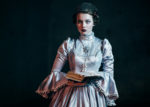
Hey, everyone! Some of my most popular posts of all time are about story plot ideas, and there are really good plot ideas in old novels.
Of course, if you’re learning how to write historical fiction in the Regency or Victorian periods, any of these books would probably be great inspiration. But you can take any of the plot ideas in a new direction, in any setting or time period you like. In some cases I’ve taken liberties with the description to make them more general, and they’re often just a part of the plot of the novel.
It’s okay to use this post as a story generator, since all of these novels are in the public domain. In fact, a lot of great writers have done it! The award-winning novel On Beauty by Zadie Smith was loosely based on E.M. Forster’s Edwardian-era novel Howard’s End . The delightful 1990s movie Clueless was a contemporary adaptation of Jane Austen’s Emma . Austen’s Pride and Prejudice was a huge inspiration for Helen Fielding’s Bridget Jones’s Diary , a book which I think is underrated in terms of literary quality, probably because it’s such a fun read.
It took a while to put this list of novel plot ideas together, but it was really fun, because some of these are my very favorite books. Here’s the list, and you might want to bookmark it or pin it to Pinterest for future inspiration!
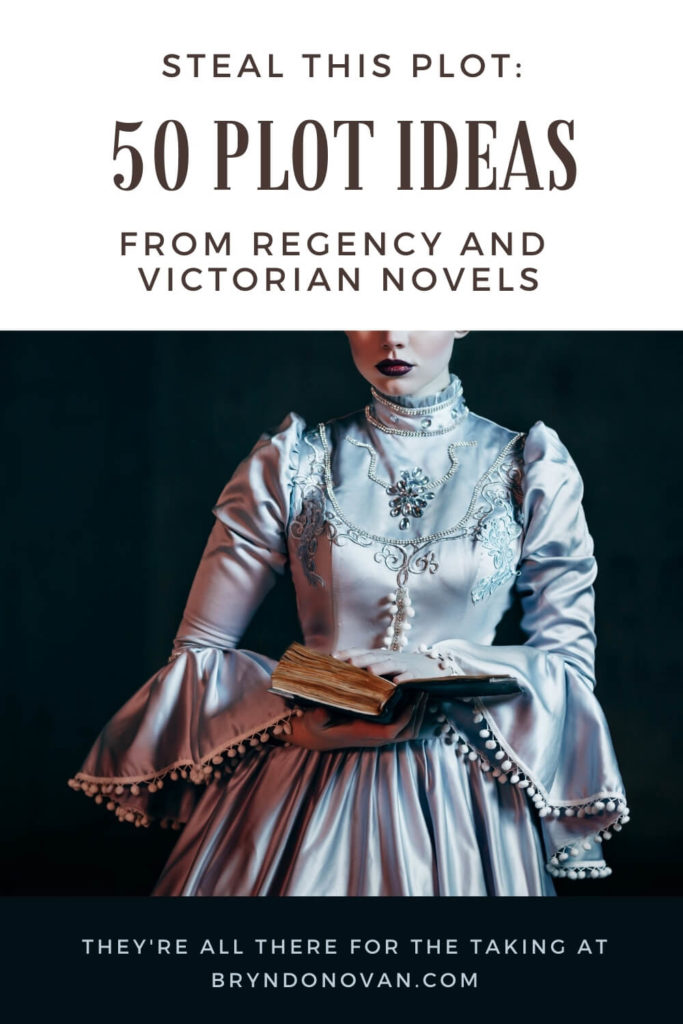
- A man who was framed for a crime he didn’t commit escapes prison, makes a fortune in another country, and returns in disguise to get vengeance on his enemies. ( Count of Monte Cristo , Alexander Dumas.)
- An orphan boy falls in love with his foster sister. As an adult, he’s still obsessed with her even though she’s married to somebody else. ( Wuthering Heights , Emily Brontë.)
- Members of a club decide to each travel to a different place and then report what they learn back to the group. ( The Pickwick Papers , Charles Dickens.)
- A rich man proposes to a young employee of his only to learn that she’s already secretly married to his son. ( Vanity Fair , William Thackeray. This is a pretty juicy story plot idea, no?)
- A man searching for a sea monster meets a guy with a fantastic submarine and they explore the ocean depths together. ( Twenty Thousand Leagues Under the Sea , Jules Verne.)
- A guy falls in love with a woman who spurns him. Later, he gets a job and then realizes she owns the business. ( Far From the Madding Crowd , Thomas Hardy.)
- In the future, humankind has evolved into two separate species. ( The Time Machine , H.G. Wells.)
- A woman who’s new in town believes the owner of a local business is unfair to his employees, but later she falls in love with him. ( North and South , Elizabeth Gaskell.) (There is a fantastic miniseries of this one!)
- A young man steals money from her father in order to leave the country and elope with her boyfriend against her father’s wishes, but then her fiancé gambles the money away. ( The Way We Live Now , Anthony Trollope.)
- A man is found dead in a room with a word written in blood on the wall, but there are no wounds on the corpse. ( A Study in Scarlet , Arthur Conan Doyle. This is the first of the Sherlock Holmes stories, when he and John Watson are just becoming friends.)
- A man believes a woman he loves is having an affair, but she’s actually meeting with her brother. ( The Tenant of Wildfell Hall , Anne Brontë.)
- A man arranges for the abduction of his recently orphaned teenage nephew because the kid is the rightful heir to a family estate. ( Kidnapped , Robert Louis Stevenson.)
- A poor child falls asleep in a stream and becomes a magical water creature. ( The Water Babies , Charles Kingsley. When I was a kid, this book blew my mind.)
- A woman refuses two marriage proposals from good guys and marries a foreigner who winds up being mean to her. Much later, one of her former suitors takes an interest in her daughter, while the other one tells her he’s still interested in her. ( Portrait of a Lady , Henry James.)
- A boy fakes his own death, runs away from home, and teams up with another runaway for adventure. ( Huckleberry Finn , Mark Twain.)
- A mistreated animal comes into a better situation. ( Black Beauty , Anna Sewell.)
- On his deathbed, a father leaves his son a mysterious artifact with an equally mysterious message inside. ( Little Dorrit , Charles Dickens.)
- A young man falls in love with the girl next door, but she rejects him because she sees him as a brother. Later, when he’s on vacation, he crosses paths with the girl’s sister, and those two fall in love. ( Little Women , Louisa May Alcott.)
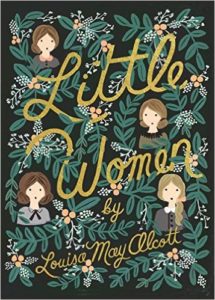
- A cynical slacker redeems himself by trading places with a great guy who’s been imprisoned and dying in his place. ( A Tale of Two Cities , Charles Dickens. Sydney Carton is one of my literary crushes.)
- A rich man runs over and kills a poor child in the street, but he shows no remorse. Later, he is murdered in his bed. (Also A Tale of Two Cities , Charles Dickens.)
- A woman is caught in a love triangle between her fiancé and her fiancé’s father. ( The Brothers Karamazov , Fyodor Dostoyevsky.)
- A man desperately seeks money to pay what he owes to his fiancée so that he can leave her and run off with the woman he really loves. He then finds out that the woman he really loves has taken up with a former boyfriend again. (Also T he Brothers Karamazov , Fyodor Dostoyevsky. There are a lot of good plot ideas in this book!)
- A person never ages due to a sinister spell. ( The Picture of Dorian Gray , Oscar Wilde.)
- A girl follows an animal guide to a strange new world. ( Alice in Wonderland , Lewis Carroll.)
- Facing the facts of his mortality, his unpopularity, and his worthless existence, a man makes a drastic change for the better. ( A Christmas Carol , Charles Dickens.)
- A man forgives his wife and his wife’s lover for having an affair. His wife’s lover is so embarrassed he attempts suicide, but fails. The adulterers then run away together. ( Anna Karenina , Leo Tolstoy.)
- A young woman teaching at a school abroad develops relationships with both the schoolmaster and a rich doctor. ( Villette , Charlotte Brontë.)
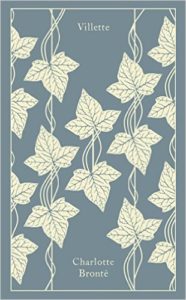
- A respectable man has a secret and horrible past: he sold his wife and baby daughter. ( The Mayor of Casterbridge , Thomas Hardy.)
- A bitter old man gets robbed and becomes the foster father for a little girl. ( Silas Marner , George Eliot.)
- A woman marries an old man who has no interest in her, but becomes friends with an interesting guy her own age. When the woman’s elderly husband dies, he leaves a note in his will that she can’t inherit anything if she marries the younger guy she’s friends with. ( Middlemarch , George Eliot.)
- A woman only realizes she’s in love with her good friend after another woman falls in love with him. ( Emma , Jane Austen. I really recommend Austen’s novels for anyone who’s learning how to write historical fiction in the Regency period. Persuasion is my favorite Austen novel.)
- Nobody knows that this beautiful young bride faked her own death, abandoned her child, and assumed a new identity in order to find a wealthy husband. ( Lady Audley’s Secret , Mary Elizabeth Braddon.)
- Aliens attack a country on planet Earth and crush its human army, but then they all die of some alien disease. ( The War of the Worlds , H.G. Wells.)
- An orphan becomes a criminal’s apprentice. ( Oliver Twist , Charles Dickens.)
- A woman gets news that the man she was once in love with has gotten married to girlfriend. Later, she learns she was mistaken – the man’s girlfriend dumped him to marry his brother instead. ( Sense and Sensibility , Jane Austen.)
- A young woman is heartbroken when the dashing and charming man she loves ignores her and then breaks up with her. After she recovers from a dangerous illness, she receives attentions from a man who’s loved her all along. (Also Sense and Sensibility , Jane Austen.)
- After discovering that his grandmother was a fairy, a young man’s room turns into an enchanted wood in Fairy Land. ( Phantasies, a Faerie Romance for Men and Women , by George McDonald.)
- The statue of a woman comes alive. She runs away, and man searches for her. (Also Phantastes, a Faerie Romance for Men and Women , by George McDonald.)
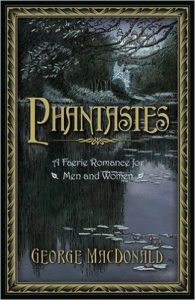
- A woman is punished and ostracized for adultery while her husband, in disguise, seeks revenge on her lover. ( The Scarlet Letter , Nathaniel Hawthorne.)
- In a remote location, a scientist creates grotesque human hybrids. ( The Island of Dr. Moreau , H.G. Wells.)
- A young man manages to pick fights with three different guys in one afternoon, but they all wind up being friends. ( The Three Musketeers , Alexander Dumas.)
- A young man impersonating someone else has a romantic rendezvous with a rich woman. In doing so, he learns a secret about her that leads her to try to get him killed. (Also The Three Musketeers , Alexander Dumas.)
- A man makes a large bet with his friends that he can travel a large distance in a short time frame. ( Around the World in Eighty Days , Jules Verne.)
- A mild-mannered teacher at a school snaps and beats up an abusive headmaster. ( The Life and Adventures of Nicholas Nickleby , Charles Dickens.)
- A man is in love with a woman who’s marrying some rich and selfish old man who’s offered to pay off her father’s debt in return. (Also The Life and Adventures of Nicholas Nickleby , Charles Dickens.)
- A young woman falls in love with her employer only to learn that he’s married to a woman he keeps locked up. ( Jane Eyre , Charlotte Brontë.)
- A man falls in love with a woman, but she’s pretty mad at him because she found out he talked another guy into breaking up with her sister. ( Pr ide and Prejudice , Jane Austen.)
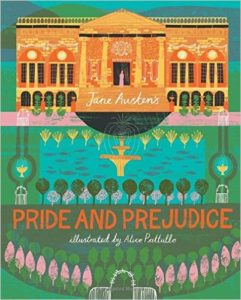
- A mischievous boy develops a huge crush on a girl at school, but he keeps messing things up with her. ( The Adventures of Tom Sawyer , Mark Twain.)
- A boy secretly witnesses a murder and is scared to tell anyone, even when the wrong man is blamed for it. (Also The Adventures of Tom Sawyer , Mark Twain.)
- A relentlessly cheerful man’s good nature is tested when he moves to a dangerous and difficult new place. ( Martin Chuzzlewit , Charles Dickens.)

I hope this was helpful for you, and if you want more plot ideas and inspiration, check out my book 5,000 Writing Prompts , which includes hundreds of plot ideas ready for the taking.
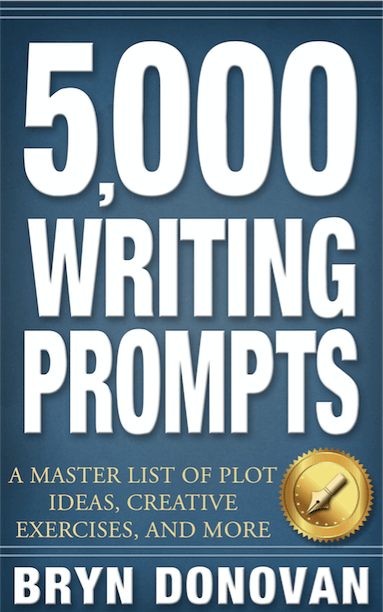
Whether you’re doing NaNoWriMo or you’re just writing at a pace more suited to a sensible human being, I wish you the best. Thanks for visiting the blog, and happy writing!
Related Posts
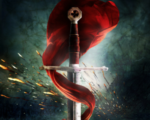
Share this:
19 thoughts on “ 50 story plot ideas from victorian and regency novels ”.
I love this list not only for the ideas but for the whole art behind taking the plot of some true classics and boiling it down to one line. Great job!
Thanks so much, Anne! Some of these were pretty hard to distill 🙂 Thanks for reading!
Great post. It really got me thinking. You’re right, these plots could work with any era and genre. I already have my idea for NANO but plan to keep this list for future reference. Thanks!
So glad you liked it, Lori 🙂 Have a great NaNoWriMo!
You know what is so wonderful? A classic is a classic is a classic. That is what makes these stories so great, they are timeless! Thank you, Byrn Donavan, for posting these.
Hi Becky! That’s so true… some themes stay relevant no matter what! Thanks so much for the kind words.
I hadn’t thought of recycling some of these, but I am now, thanks! Are you tackling NaNo this year, Bryn?
Thanks, Carolyn! Ahh, that’s a good question. I really shouldn’t. I have so many things going right now. But dang, I am so tempted to use NaNo to finish my knight story… We shall see! Are you doing it?
Hi Bryn! I do NaNo every year even though I’m a ghostwriter. I was told that as long as I was writing, it counted toward the 50k goal. However, if I’d already begun the story, only the words written in November could be used for NaNo. For the last several years, I’ve been doing it this way and I’ve always reached or exceeded 50k. 🙂
Hey there Robin! Yeah, that’s what I’m thinking about: just using the work done in November toward the NaNo count. 🙂 I’ve only done NaNo once before — congratulations on so many wins 🙂
- Pingback: My Current Favorite Blogs and Vlogs! | bluelacylou
Hey on a few occasions you say “a man” but mean a woman. I was wondering how the Victorians were so open about gay relationships…
- Pingback: ? Writing Links Round Up 11/19-11/24 – B. Shaun Smith
This is my second visit to your site today and both from google searches! 😀 But for this one, I spent the entire post seeing if I could remember the plot. I’ve read all but a couple but there were some I didn’t remember the plot. Like, in Anna Karenina I thought she committed suicide at the end. But that is besides the point. Now I have to get back to my Regency novella where I am stuck.
Ha ha! I’m glad my SEO is working, Jennie. 🙂 In Anna K., she does commit suicide in the end (sorry for the spoilers, readers.) Good luck on the Regency novella!
- Pingback: Fiction Secrets: 5 Tips To Write A Novella Fast
- Pingback: How I Get Thousands of Page Views On My Blog Every Day… With Pinterest
Love North and South. The book was a little difficult to read, given the older language, but the story is awesome. The series….I’ve watched numerous times.
- Pingback: Regency Era Names
Leave a Reply Cancel reply
This site uses Akismet to reduce spam. Learn how your comment data is processed .
Discover more from BRYN DONOVAN
Subscribe now to keep reading and get access to the full archive.
Type your email…
Continue reading
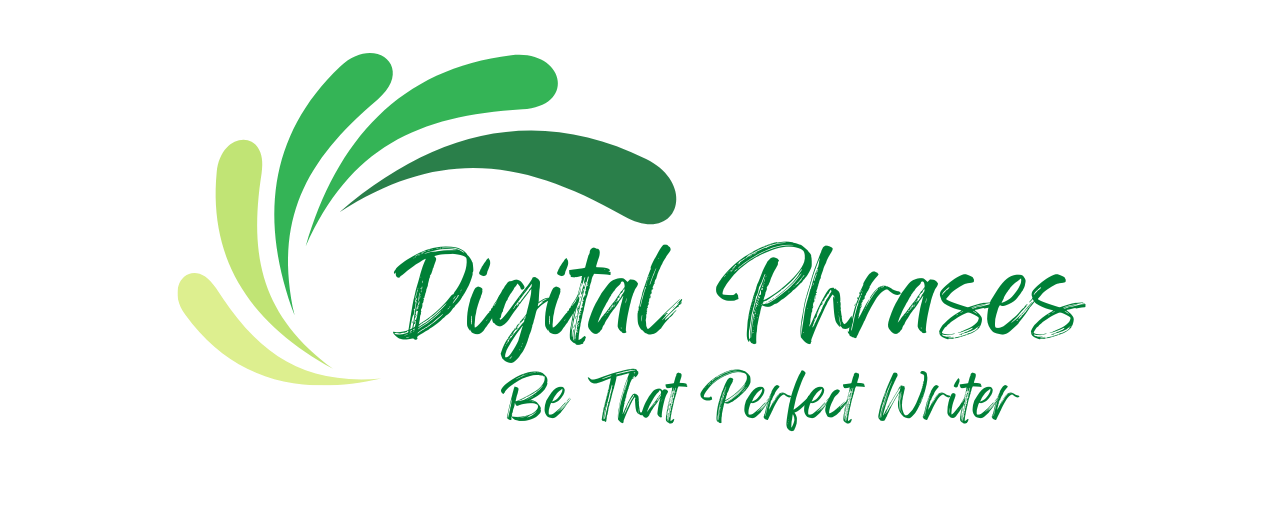
32 Victorian Story Ideas
Feeling the urge to unleash your inner Charles Dickens or dip a quill into some Victorian mystery ?
You’ve come to the right place.
The Victorian era, with its foggy streets, rigid social codes, and whi whi of technological innovation, is a treasure trove for writers.
But where do you even begin to craft your own tale?
Fear not, fellow scribes!
This post is brimming with story ideas to spark your Victorian imagination .
From high society scandals to dark supernatural chills, let’s dive into a world of top hats, tea parties, and thrilling adventures !
Victorian Story Ideas
- In the bustling heart of London, a prominent inventor creates the first-ever automation that mimics human behavior to near perfection. As the elite clamor to own one , it’s discovered that these automations are being used to replace real people in powerful positions. As the line between machine and man blurs, a young reporter tries to unveil the truth before society crumbles. But she must decide if revealing the truth is worth the chaos it could unleash.
- Following the passing of Lady Eleanor, a family comes together to read her will. Instead of monetary legacies, she’s left behind a series of mysterious riddles, each leading to a personal heirloom for every family member. As each member embarks on their individual quests , they uncover dark family secrets and memories best left forgotten. The heirlooms hold power , and not all are meant to be found.
- An artist renowned for his portraits is commissioned by a wealthy family. His subject is their melancholic daughter, Lillian. Upon completion, however, the family notices that the portrait seems to subtly change day by day, reflecting Lillian’s deepest emotions and secrets. When Lillian goes missing, the portrait may be the only key to finding her.
- At the Dunbridge estate, a series of mysterious accidents plague the staff. The housemaids, tired of the blame, band together to solve the mystery. Their investigations lead them to an underground network of women influencing the politics and commerce of the city. In a world dominated by men, these women pull the strings from the shadows.
- Thomas, a humble lamplighter, begins to notice strange occurrences each night as he lights the street lamps of London. Whispered conversations, fleeting shadows, and unexplained phenomena become a regular encounter. Realizing he’s inadvertently lighting the path between the living and the spectral world, Thomas must find a way to mend the rift. But the spirits have requests of their own.
- A young woman purchases an old diary from a market stall. As she reads, she realizes it belongs to a woman from the 19th century who led a double life : a respectable Victorian lady by day and a fearless vigilante by night. Intrigued, she decides to trace the woman’s lineage and discovers a legacy she never knew she had. The diary is not just a story; it’s a calling.
- Hazel, a talented seamstress, stitches stories of love , loss, and hope into every garment she crafts. One day, a traveling musician purchases a scarf and finds himself overwhelmed by emotions and memories that aren’t his own. He seeks Hazel, and together they explore the mysterious connection between her stitches and his melodies. In a tapestry of fate, their lives intertwine in ways they never imagined.
- On the renowned Orient Express , a diverse group of passengers boards for a journey across Europe. Among them is a detective chasing a notorious thief rumored to be on the train. As they travel, it becomes clear that every passenger has a secret, turning the journey into a thrilling game of deception and revelation. On the moving train, trust is fleeting, and time is running out.
- Every morning, verses of a hauntingly beautiful sonnet appear etched onto the foggy windows of London’s carriages. The source remains unknown, but the poems predict events of the day. Lydia, an aspiring poet herself, becomes obsessed with finding this mysterious sonneteer. Yet, when she gets close, she’s faced with a truth stranger than fiction .
- An apothecary, known for mundane remedies, accidentally concocts an elixir granting brief glimpses of the afterlife. As word spreads, the demand becomes insatiable, leading to moral dilemmas and spiritual unrest. People are torn between the comforts of life and the allure of the afterlife’s mysteries. The veil between worlds grows thin, threatening to dissolve entirely.
- In the coastal town of Stormhaven, every tempest is followed by melodies drifting from the sea, causing the villagers to dance involuntarily. A journalist from London, drawn by this oddity, arrives for a story. As he delves deeper , he’s introduced to ancient maritime legends and forbidden romances. The sea has tales to tell, and its songs harbor deep secrets.
- An intricately designed cameo brooch is auctioned off, changing hands among the Victorian elite. However, each owner meets an unfortunate fate. Isabelle, a budding historian, believes the brooch belonged to a wrongly accused witch who vowed revenge . To break the curse, Isabelle must uncover the buried truths of a bygone trial.
- A masked pianist, known only as the Veiled Virtuoso, performs exclusively in private salons, captivating audiences but never revealing their identity . Charlotte, a music critic, is determined to unveil the maestro, but as she pursues the story, she encounters a world of intrigue, romance, and deception. Behind the mask lies a story of sacrifice and stolen identities.
- Underneath the bustling streets of London lies a hidden sanctuary for those with supernatural abilities. Here, they live, train, and protect their secrets. Amelia, born without powers but aware of this hidden world, stumbles upon a plot to expose and eradicate these individuals. In a race against time, loyalties will be tested and destinies defined.
- During the Victorian era’s obsession with spiritualism, a renowned medium claims she can weave tapestries capturing one’s dreams . But when nightmares start manifesting in reality, suspicion falls upon her. Eleanor, a loyal client, sets out to defend the medium’s name and discovers a tangled web of envy, ambition , and suppressed desires. Every stitch unravels a new enigma, leading Eleanor down a perilous path.
- Lancaster House, a sprawling mansion, is said to rearrange its rooms every midnight. An adventurer, lured by tales of treasures and artifacts, ventures inside, only to find himself trapped in its ever-changing maze. As he navigates the labyrinth, he uncovers stories of previous occupants and their fates. To escape, he must piece together the house’s haunting history and appease its restless spirits.
- Throughout London, tales circulate of a mysterious benefactor aiding those in dire need, leaving behind only an emblem of a raven as a signature. Margaret, an orphaned bookkeeper, begins connecting the dots between the beneficiaries, discovering they all share a forgotten bond. As she nears the philanthropist’s identity, she unravels a tapestry of old debts and ancient vendettas.
- In an era where mesmerism sweeps the nation, a particularly skilled practitioner captivates audiences with his entrancing abilities. However, whispers arise when his subjects begin recalling past lives with uncanny accuracy. Cecilia, a skeptic, volunteers and is confronted with memories of a life she never lived. Pulled into the past, she must decipher illusion from reality.
- The most renowned opera house in London harbors a secret: its star performer, known only as the Nightingale, has never been seen offstage. Rumors suggest she’s imprisoned by the enigmatic owner. A young journalist, Edward, infiltrates the theater, finding himself ensnared in a tale of love, betrayal , and ambition. Behind the velvet curtains, melodies mask mysteries.
- On the shores of Brighton, intricately carved driftwood pieces appear overnight, depicting scenes from townsfolk’s most guarded secrets. Clara, a coastal dweller, collects these relics, realizing they foretell future events. As the town grapples with the unveiling of its innermost secrets, Clara seeks the elusive artisan behind the prophetic driftwood. In the dance of waves and wood, destiny takes shape.
- Beneath the city’s cobblestones, a network of forgotten tunnels is discovered, rumored to be the hiding place of a vagabond’s enormous treasure. Adventurers and treasure hunters converge, but the tunnels are riddled with riddles, traps, and echoes of the vagabond’s life. The treasure, it seems, isn’t gold or jewels but something far more valuable. In the heart of darkness, true wealth is revealed.
- An enigmatic shop appears overnight in London’s East End , peddling obsidian mirrors said to reflect one’s darkest truths. Those brave enough to gaze are either liberated or driven to madness. Alice, mourning her twin sister’s disappearance, seeks the mirror’s clarity and is drawn into a reflection of twisted realms and shadowed truths. In the depths of obsidian, lies and liberation intertwine.
- At the height of puppetry ’s popularity, a marionettist’s creations come eerily to life, mirroring their puppeteer’s emotions. As his fame grows, a series of accidents befall his rivals. Suspicion mounts, but is the puppeteer truly at fault, or is there a more sinister force pulling the strings? In the theater of strings and souls, guilt is a complex play .
- A clandestine underground railway operates at midnight, said to transport passengers not through space , but time. Beatrice, seeking to amend a regretful past decision, boards the train, journeying through pivotal moments in Victorian history. Along the way, she learns that the tracks of time are intricately connected, and altering one event can have unforeseen consequences. On the reverie railways, destiny is both conductor and track.
- Beyond the mapped waters of the British Isles, charts speak of an uncharted island where reality bends. Shipwrecks from centuries past eerily inhabit its shores. Sir Benjamin, an explorer, reaches the island, only to find it governed by an illusionist whose tricks challenge the very fabric of reality. In this realm, shadows play, and what’s lost might never be found.
- A derelict manor’s dovecote becomes the secret refuge for a mysterious dancer who performs only at dawn. Word spreads, and people travel from afar to witness her ethereal grace. Amelia, a writer, seeks to pen the dancer’s tale but discovers a history of love, rebellion, and a curse that binds the dancer to the dovecote. Feathers, fate, and freedom interlace in an intricate ballet.
- Young chimney sweep Oliver discovers ancient runes inside a grand mansion’s flue. When touched, they transport him to moments in the mansion’s storied history. As he unravels the estate’s legacy, he finds himself entangled in past injustices, conspiracies, and a legacy that might change his future. Through soot and secrets, history has a way of cleansing itself.
- Sailors whisper of an elusive mirage: a city floating on the ocean ’s horizon, vanishing at dawn. Captain Nathaniel, seeking glory and answers, sets his course for the spectral city. What he finds challenges his beliefs: a realm where sea legends reside, and humanity’s forgotten tales come to life. In the embrace of waves, legends live, and myths matter.
- An enigmatic carnival arrives in London, open only from midnight to dawn. Attractions defy natural laws: endless labyrinths, gravity-defying performances, and creatures of legend. As its allure grows, some visitors begin to disappear. Eliza, a detective, ventures into the carnival’s heart, discovering that it’s a sanctuary for the supernatural, seeking refuge from the modern world. Beneath twinkling lights, magic seeks a hiding place.
- In the gardens of Warwick Estate, topiaries change shape overnight, depicting scenes from the family’s history. As the 20th century looms, they begin showcasing future events. Helena, the estate’s heiress, must decipher the shrubs’ warnings and confront her family’s murky legacy. In twisted leaves and trimmed branches, nature narrates tales of time.
- In a secluded London alley, an alcove materializes every new moon , displaying wares with transformative powers. Those who purchase find their fates altered. Richard, an impoverished scholar, stumbles upon this alcove and is faced with moral dilemmas when offered a potion that promises fortune but at a mysterious cost. In vials and visions, choices carry consequences.
- Madame Isabelle’s Wax Museum is renowned for its lifelike figures, but a chilling rumor emerges: some figures are a little too lifelike. When guests start recognizing likenesses of missing individuals, an investigator, Mr. Hawthorne, probes deeper. He discovers a sorcerous warden trapping souls within wax, preserving stories of tragedy and triumph. In molten memories and solidified silhouettes, souls find their sanctuary.
Founder and Chief Content Curator @ Digital Phrases
I'm a writer, words are my superpower, and storytelling is my kryptonite.
- Skip to main content
- Skip to primary sidebar

Writing Tips Oasis - A website dedicated to helping writers to write and publish books.
How to Write a Story Set in the Victorian Era: 10 Top Tips
By Rebecca Parpworth-Reynolds

In this post, we show you how to write a story set in the Victorian era through the following 10 top tips. Read on to find out more!
1. Understand Victorian sensibilities
One of the most important things to take into consideration when it comes to writing a story set in the Victorian era is to understand exactly what it means to be Victorian. This may sound obvious, but it is actually critical when it comes to nailing stories written during this time.
The Victorians had a very distinct sense of sensibility that characterizes how we view them today. This affected their approach to a multitude of aspects of life. Despite the rapid technological progress of the era from the Industrial Revolution, the Victorian mindset was very much hinged upon “traditional” values. This included gender and family roles, fulfilling your allotted role in society, and showing restraint when it came to emotions and affections.
As a result, if you are writing about this era, it’s best to consider all of your characters as incredibly “rigid” in their beliefs and sensibilities to start. Then, with further character development, you will start to see where your character may not align with these views, allowing you to use these to underpin your narrative and their individuality as a character.
2. Research the fashion
Fashion was incredibly important to the Victorians, especially depending on your social class and moral standing.
Women would be covered completely using dresses with long sleeves and full skirts supported by a crinoline. Corsets would often be tight, and heads would be covered with bonnets. However, towards the latter part of the Victorian Era in the 1870s and 80s, a push towards showing the figure resulted in much thinner and slimline styles of dress that directly contrasted this.
Men were experiencing the move from breeches to trousers, with the development of what we would consider the modern suit taking place during this era. One important thing to consider was how, just like women were restricted with corsets, men would be restricted too with high, stiff, and starched collars that would limit movement and could sometimes cut off airflow!
If you have older characters in your story, you might also want to look at older fashions that might sit outside of the Victorian era, too, as a way to show a character that hasn’t caught up with the times or that is stuck in their ways.
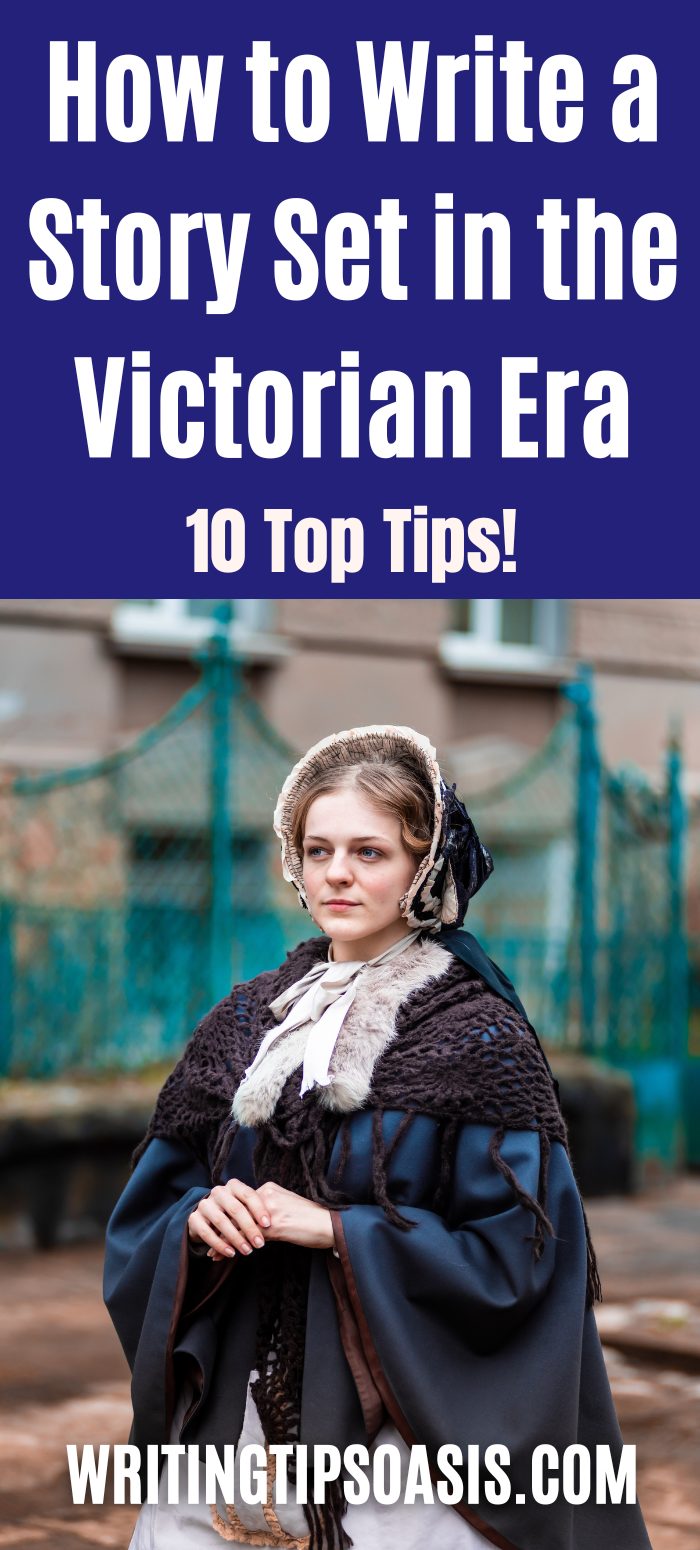
3. Get a grip on religion and morality
Building on from the idea of Victorian sensibility, a lot of this was underpinned by religion and perceived ideas of morality and modesty.
Ideas around restraint and moderation were strongly touted by almost all forms of Christianity prevalent in this period, with the Anglican church being at the forefront of this. Other offshoots such as Calvinism also had this regulated approach.
Religion was also used to highlight and spur action against the plight of the working classes, such as the Methodist and Quaker churches which shied away from conformist practices of the Church of England. If your character is of the working class or looking to shape social reform, this would have been one of the ways that they would have done this.
However, towards the middle part of the 19th century, religion began to be called into question, especially with the release of Darwin’s On the Origin of Species. This led many to experience religious crises, and so it is worth bearing in mind when considering the development of the characters in your Victorian-era story.
4. City vs country
The location of your Victorian-era story is also important, as it will affect the way in which you approach things.
Cities were densely populated, where people often lived in crowded and poorly built tenements or terraced houses, lacking proper sanitation and adequate living space. In exchange for this, there were far more job opportunities in the new factories, leading many people to leave the countryside to seek employment.
The countryside, on the other hand, had much smaller and scattered populations, with communities often centered around farms and villages and a closer connection to nature, which was reflected in traditional farmstead living and artisanal crafts.
Those from the country would likely be seen as naive by their city-dwelling companions, so a fresh-faced country bumpkin will have a rude awakening to city life and acclimation. Those still living in the country had to battle the influence between old ways and the new, with cities ever expanding and encroaching onto once pastoral land.
5. Rich vs poor
There was a great poverty divide in the Victorian era between the rich and the poor, especially within the city and urban environments.
The rich were often land and business owners, meaning that often the poorest in society had to rely on them not only for the housing that they rented but for their jobs as well. This created an unwilling dependence on those at the top of the social ladder, which was very hard to escape.
Depending upon what background your characters have, you will need to think carefully about the realities of their situation. Although “rags to riches” stories were incredibly popular at the time, without some sort of long-lost-relative or major act of good fortune, it was hard for people to elevate themselves. Therefore, you’ll need to get creative when it comes to how you advance your characters forward through your story.
6. Industrial Revolution
One of the massive factors behind the Victorian era was the Industrial Revolution when steam power revolutionized the way in which the world worked.
This ranged from being used to forge the way for rail travel, connecting the country, as well as to power the multitude of factories that arose to cater to the growing population. This led to a mass migration to crowded cities that became filled with grime and disease despite the technological advances of the age.
Depending upon the age, gender, background, and home of your characters, the Industrial Revolution will affect them in different ways, so it is important to consider not only its impact on their lives but also their opinion on this rapid change.
7. The effects of Empire
The Victorian era was also characterized by its Empire, spanning across the globe. This influence and power could be felt across many nations, including the occupation of India and many countries in Africa.
Although not many of those from across the Empire ended up in Britain, it’s still worth remembering the effect that the Empire had on Victorian people and their sense of pride as a “great” nation of the world.
This is especially true of those who choose to explore the Empire or take roles within it, which can be an avenue to explore in your novel.
8. The gender gap
When writing a novel set in the Victorian era, it’s, unfortunately, a sad fact that sexism and the gender gap will exist in the time that you are writing about.
There were completely different social expectations for men and women, with traditional gender roles of women staying at home and raising the children being expected. This meant women had to face the turmoil of having to leave their jobs if they chose to get married: they could not have both.
However, the poor often did not have the luxury of the wife staying at home, and often women in the working class would have to go to work and also take care of family duties.
Towards the end of the Victorian era, women started to earn more freedoms and luxuries, including access to bicycles, which gave them much more freedom of movement even if they were politically stifled. It’s worth noting that this was only an opportunity for those with money, so you’ll need to think about what circumstances will hold up for the female characters in your story without being too far-fetched.
9. Be aware of the decade
As the Victorian era was a time of rapid development and invention, things were continually changing.
This means that depending upon the decade, or even the year in which your Victorian novel is set will be incredibly important when it comes to researching what was happening at that time. For example, you don’t want to write about electric lamps being around in the 1850s when the technology only became commercially available in the 1870s and 80s!
A good reference point is to look up a chronology of the era focusing on the timeframe that you wish to include. This way, you can’t go wrong when it comes to what you do and don’t include! If you can find any in a library or archive, Victorian periodicals are also a great resource for understanding the time period and issues that affected contemporary people.
10 A question of prose
One question you may want to ask yourself is how far you want to go when it comes to the Victorian theme in your novel.
You may wish to take influences from Victorian prose and literary concepts, especially as this time period was when the novel as we know it today started to come to fruition. Often, sentence structure would be complex, and the narrative would be episodic with many “cliffhangers” at the end of chapters due to the way they were published in periodicals.
If you choose to write in a modern format, that’s still totally fine! One thing you might want to remember though is to look at the spoken language of the time, just to make sure any words or references you use are in keeping with the time period.
- Bookfox Academy (All Courses)
- Write Your Best Novel
- How to Write a Splendid Sentence
- Two Weeks to Your Best Children’s Book
- Revision Genius
- The Ultimate Guide to Writing Dialogue
- Your First Bestseller
- Master Your Writing Habits
- Writing Techniques to Transform Your Fiction
- Triangle Method of Character Development
- Children’s Book Editing
- Copy Editing
- Novel Editing
- Short Story Editing
- General Books
- Children’s Books
40 Writing Prompts and Ideas for Historical Fiction (with pictures!)
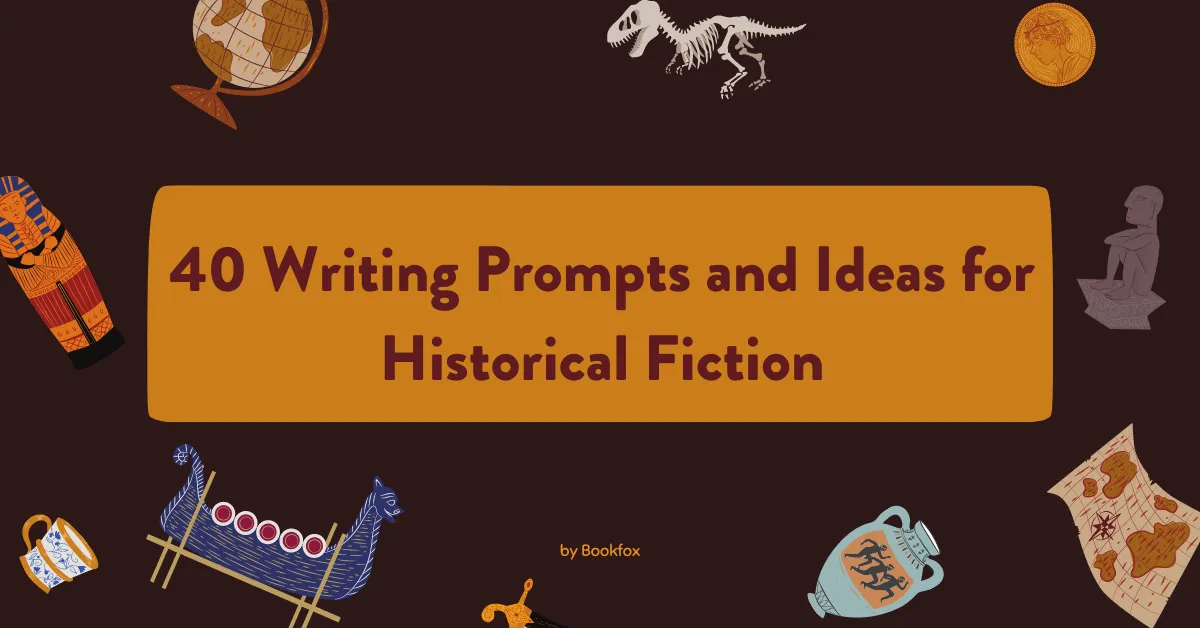
Are you a curious novelist exploring uncharted genres or are you a current writer of the past seeking new adventures?
Whatever your purpose, these 40 historical writing prompts , partnered with a collection of vintage photographs , are guaranteed to help you get ideas, transcend to an inspiring era and help you to write your own piece of history.
And once you’re done with these prompts, please visit my post on “How to Write Historical Fiction.”
1. The Lonely Lighthouse
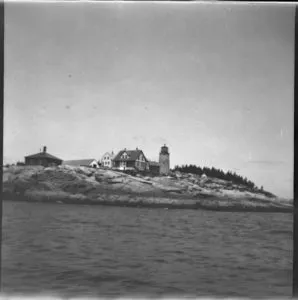
2. Behind Enemy Lines
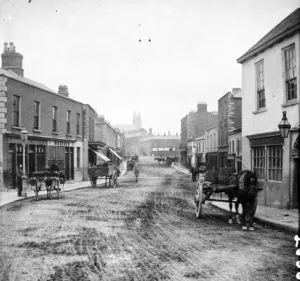
It’s 1864, and the United States is in the middle of a Civil War. Write a scene in which an undercover Union soldier passes through a quaint southern town brimming with Confederate rebels.
3. Fire at the Factory
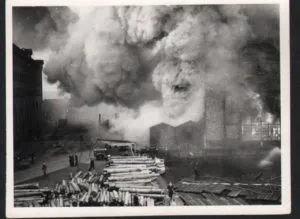
Imagine you’re an Irishman working at a factory in the 1930s. It’s your first day on the job. Without having the proper training, you accidentally set fire to the plant. Write a mock report of how the fire started and how your character escaped fault.
4. The Traveling Circus Clown
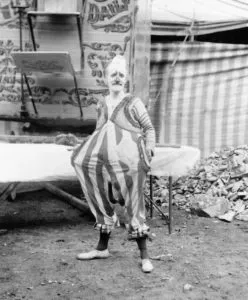
5. The French Ruler
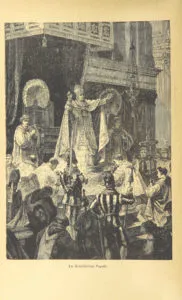
Write a chapter in the point of view of an English spy who attempts murder during Louis XIV’s coronation in 17th century France. How does your tyrant plan to execute their mission and are they successful?
6. Swan Lake
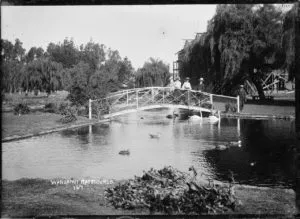
A group of close friends meet for the last time before going in separate ways in 1940s England. Write a scene about their last moment together. Do they make a pact to see each other again in 10 years or do they reminisce back in time to the day they first met?
7. Sailing Away
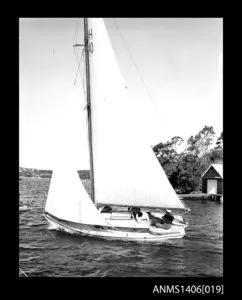
In 1950s Charleston, South Carolina, two teenagers escape the troubles of boyhood to go on an adventure of a lifetime. What conflict do they have with each other as they go on their voyage and where do they go?
8. The Dinner Bell
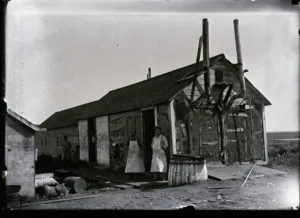
See what’s cooking in this 1940s California kitchen. Imagine you are a food columnist for the local newspaper. Write a mock interview and include a secret family recipe that accidentally gets leaked.
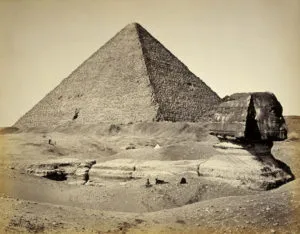
10. Aerial View Beach
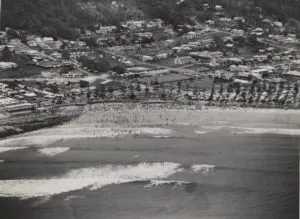
As an airplane pilot you are much more aware of what’s happening in the sky rather than the ground. Write a scene where the pilot flies over a beach and spots a crowd of beach-goers flocking to the surf. Do a 15 minute freewrite of what you see in the water.
11. Turquoise Waters

You are an inhabitant on a tropical Mediterranean island. One day you go out for a stroll along the cliffs when you notice a strange ship across the waters coming toward your home. Write one chapter where you describe who’s on board the ship and what they want. Are they friends or enemies?
12. Kooky Cribs
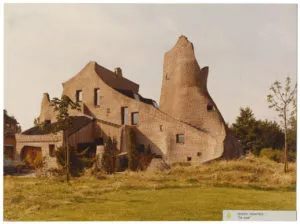
Write a story about an orphaned child in the 1970s that meets a strange family who resides in an even stranger house on the California coast.
13. He’ll Be Coming Around the Mountain
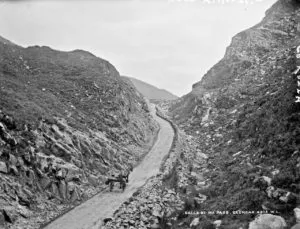
Write a scene about a family man traveling through a mountain pass in 19th century Oregon, unaware of what’s coming fast around the corner. Write a paragraph of how he connects fate with destiny.
14. Block Party
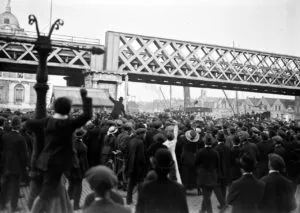
Extra! Extra! Write a scene about a group gathering in the streets of Chicago, Illnois in the 19th century. Are employees going on strike? Are women fighting for equal rights against men? Or are people cheering for the one person that could lead a hopeless village to a brighter future?
15. The Butler Did It
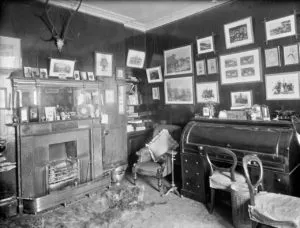
Write one chapter about a female housekeeper who explores her master’s study in 19th century France. What all does she discover and is it something that she rather not have wished to find?
16. The Long Journey Home
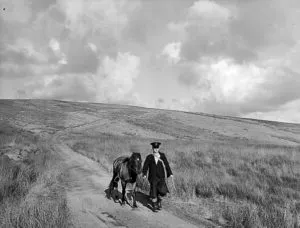
Write a story about a boy who ran from home after revealing a scandalous family secret that should have been kept jan drugs canada under lock and key. Now a man, fifteen years later, he’s returned home only to discover that there is still unrest after his plaguing mishap.
17. On Top of God’s Mountains
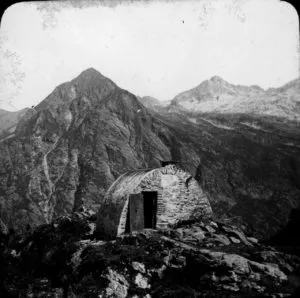
Write one chapter from the point of view of a 1970s mountain climber in Colorado, who discovers a brick hut on top of a mountain. Is it inhabited or is there a certain relic which transcends him to a different era?
18. The Road to Nowhere
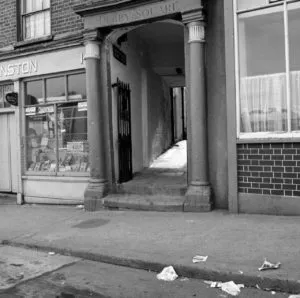
19. Buffalo Dreams
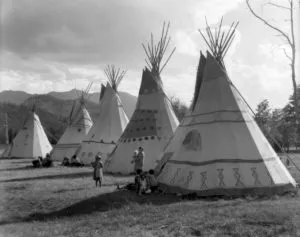
Write a journal entry in the point of view of a female pioneer of her abduction by the Sioux Indian tribe in the early 19th century.
20. Oriental Ornaments
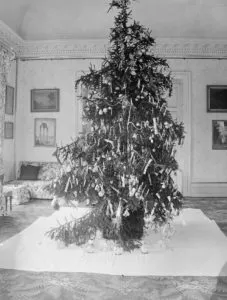
Write a story in which an ornament on a Christmas tree tells the story of a different era in time.
21. Handle with Care
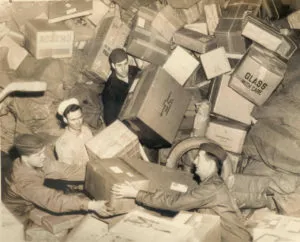
Write an outline about the adventures of four men, who meet as young postmen during WWII. What are their backstories? Give them features, disagreements, and opposing traits.
22. The Lion Tamer
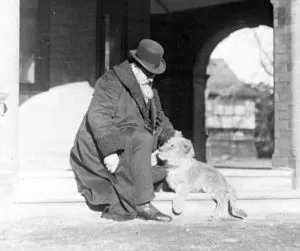
Write a character profile of a wealthy 19th century English banker, who was once a lion tamer in a past life.
23. Beauty Mark

Write a robbery scene that takes place in a popular jewelry boutique in 1960s New York. Is the jewel thief a stealthy shoplifter or a glass-shattering maniac? Does the crime take place at night when the store is closed or during business hours? And how does the robber know the jewelry store owner?
24. War Hero
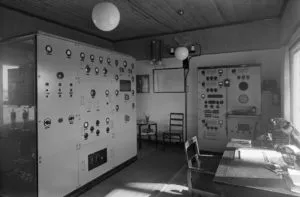
Write a scene where an undercover WWII American sneaks into a German radio room to send a message that could prove fatal to the enemy — if he isn’t caught.
25. Hotel of Haunts
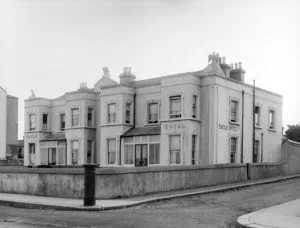
Write a flash fiction story from the point of view of an owner of a hotel that is famous for being haunted by characters from the Roaring Twenties.
26. Let’s Shake On It
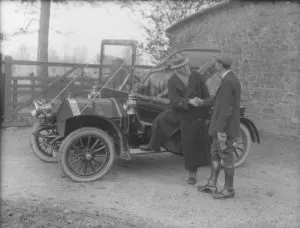
Write a story about a man who purchases a 1920 Ford Model T and discovers that the car has a life of its own.
27. Baskets, Anyone?
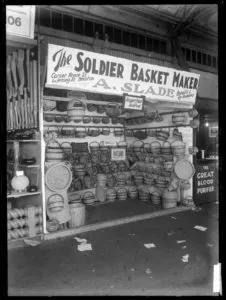
Write a story about a 1980s New Yorker looking for adventure, who purchases a basket from an eccentric city merchant and discovers an item inside that takes the character back in time to 15th century Scotland.
28. Poker Face
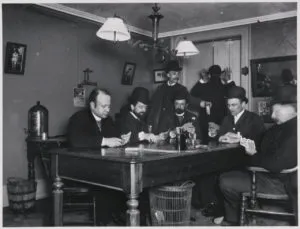
There’s no rules in this card game. Describe the high stakes for this card game in 1800s England. Does the winner wind up wishing he had lost?
29. The Diner
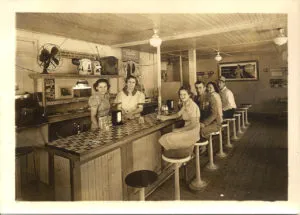
Write a story about a drifter passing through only to stop at a lone 1940s diner to get some lunch, but unintentionally ends up staying much longer than expected.
30. A Man’s Best Friend
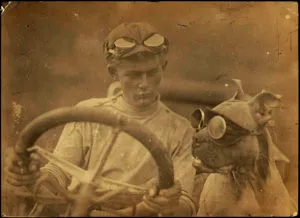
Write a story about a boy and a stray dog and their many adventures as a famous motor racer in 1920s America.
31. Dear . . .
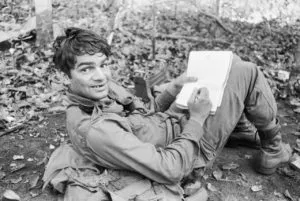
Write a letter from the point of view of a solider writing to his family during the Vietnam War.
32. Once Upon a Time
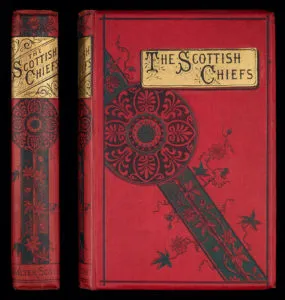
Write a story about a contemporary novelist who physically appears into his Victorian England drama and falls for his female protagonist.
33. The Kiss
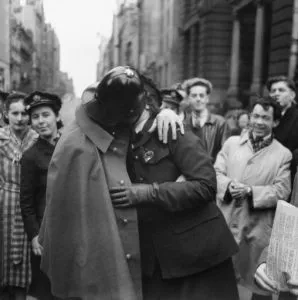
Write a love story about a female WWII veteran who saves a fireman from a burning movie theater in 1940s New York.
34. Cabin Fever
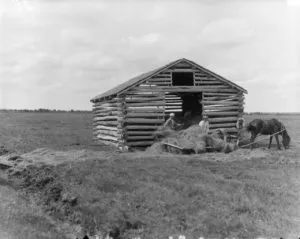
Write a story of a pioneer family from the city starting their new life on the Oregon Trail in the 1800s.
35. Under the Weather
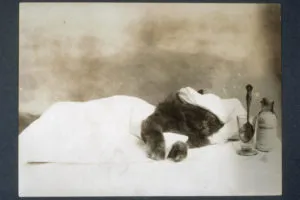
Write a story about an underrated scientist that turns out to have better ideas than most of his colleagues in 19th century Germany.
36. Summer Dreams
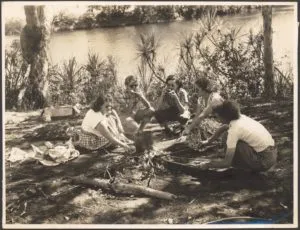
Write a story about five teenagers who first meet at a summer camp, and how their lives continue to intertwine throughout the years in 1950s Florida.
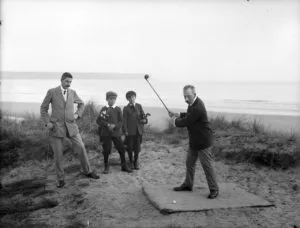
38. Fort Knox
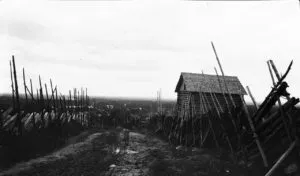
Write a diary entry of an infantry solider in the Revolutionary War who is on guard at his post when there is a sudden attack on his fort.
39. The Rogue
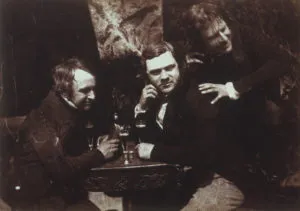
Write a character profile of a wayward Englishmen who treats the rules of proper Victorian England society like it’s a game.
40. The Highwayman
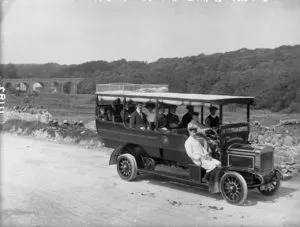
Write a scene in which the passengers of this motor car are stopped by a mysterious rider in the 1920s English countryside.
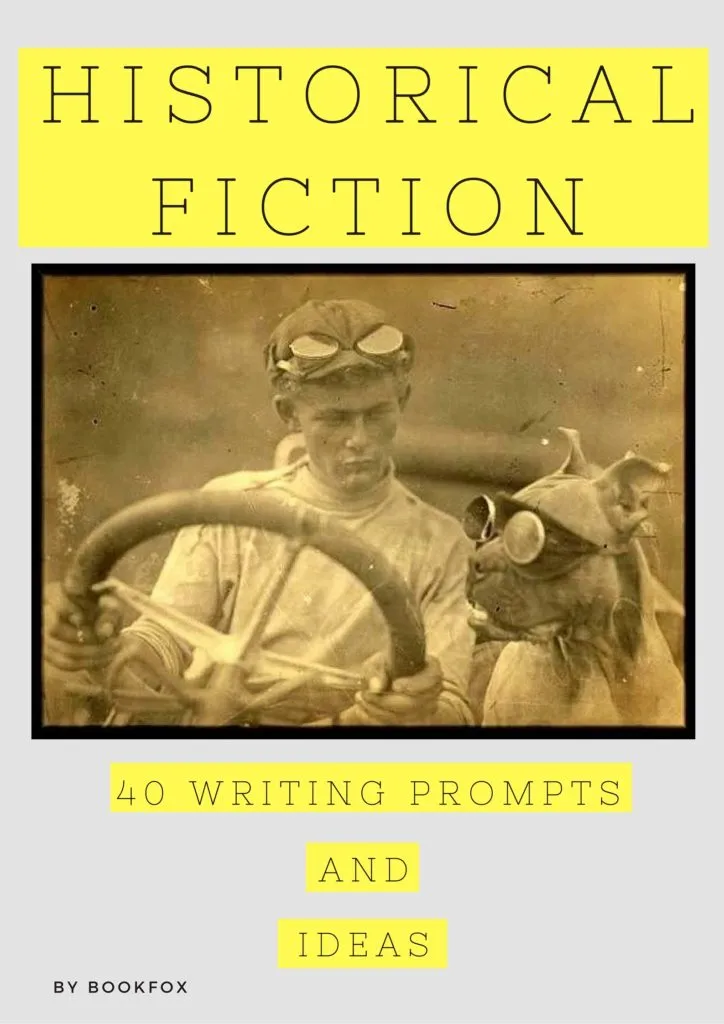
Related posts:
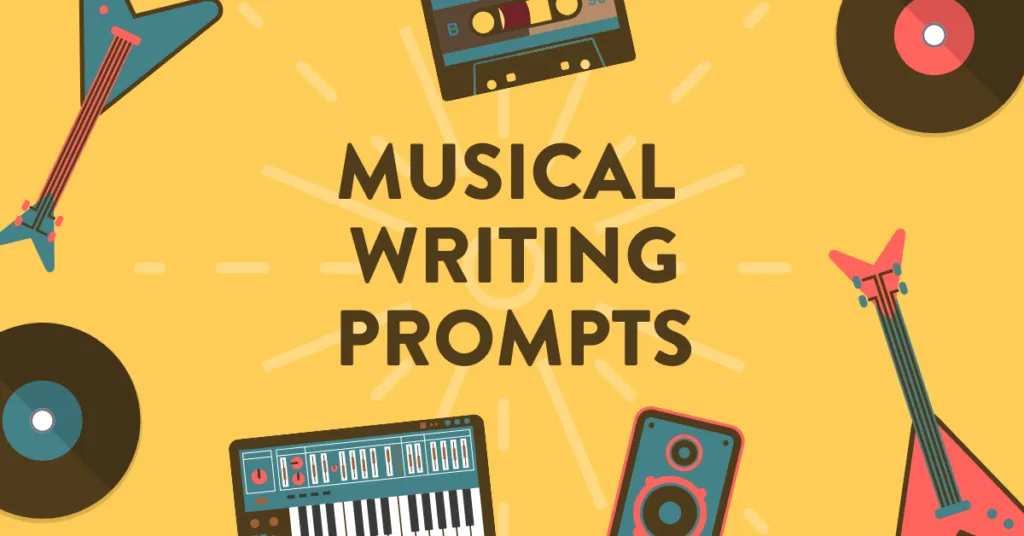
Leave a Reply Cancel reply
Your email address will not be published. Required fields are marked *
29 comments
Oh my gosh. This is awesome. Going to write a story on it☺☺☺
Thank you! Happy writing!
yes, this is utterly amazing!!! I am a student and it is awesome.
What!!!!!!!!!!!!!!!!!!
i am a student doing a story competition and yes this was great!!
Did you win?
I really like all these Ideas. The thing is, I am creating a book that mainly focuses around the age of piracy, age of exploration, and industrial revolution.. so around the timeline 1740-1800. I seem to have trouble on trying to recreate a “Similar” historical plot to that of real life.My main character Jack ater, the son of the infamous pirate allen ater, recently moves to London around the time line. From there I plan on him becoming a vigilante of some sort. I just want a bit of guidance to help me get on the right track.
Sounds great!! How’s your story going? I hope you’ve published it by now 🙂
I think that Donald Trump is history, so why isn’t he on this list.
I think you’re a dumbass. History can be a good way to learn about something, it also can show us future generations how to prevent specific events. Donald Trump is a orange dumbass. The only history that will be written about that racist orange bigot would be how he imprisoned immigrant kids and killed millions of diverse and beautiful people and so many religions so his white supremacist era could be successful.
i agree with mime
this was really helpful for my writing assignment and i love it
Oh my god this is wonderful i’m going to make a movie
I made my own topics using the given prompts and yes, It is awesome!
Thank you, these have helped me so much with my school English assignments!
I love this and this will so help me with my assignment! Thank you!
Gracias, Senor.
this is so scrumptious
This is amazing! These ideas are so creative! LOL I am going taking a “Creative Writing” elective in school. I am definitely going to base one one my stories on these prompts. Thanks!
I love these prompts! They saved my LIFE! (From getting screamed at……)
i’m writing a fictional chor story about how derek chauvin is a hero and need advice. Is murder heroic if it was on an evil person? Thanks!
Thank you! I’m using this as a reference for a book/ project idea!
i am going to use egypt
very good suggestions. Not exactly what I am looking for but provides ideas for possible themes.

Every writer NEEDS this book.
It’s a guide to writing the pivotal moments of your novel.
Whether writing your book or revising it, this will be the most helpful book you’ll ever buy.
- Join our email list

60 historical fiction writing prompts
by The History Quill
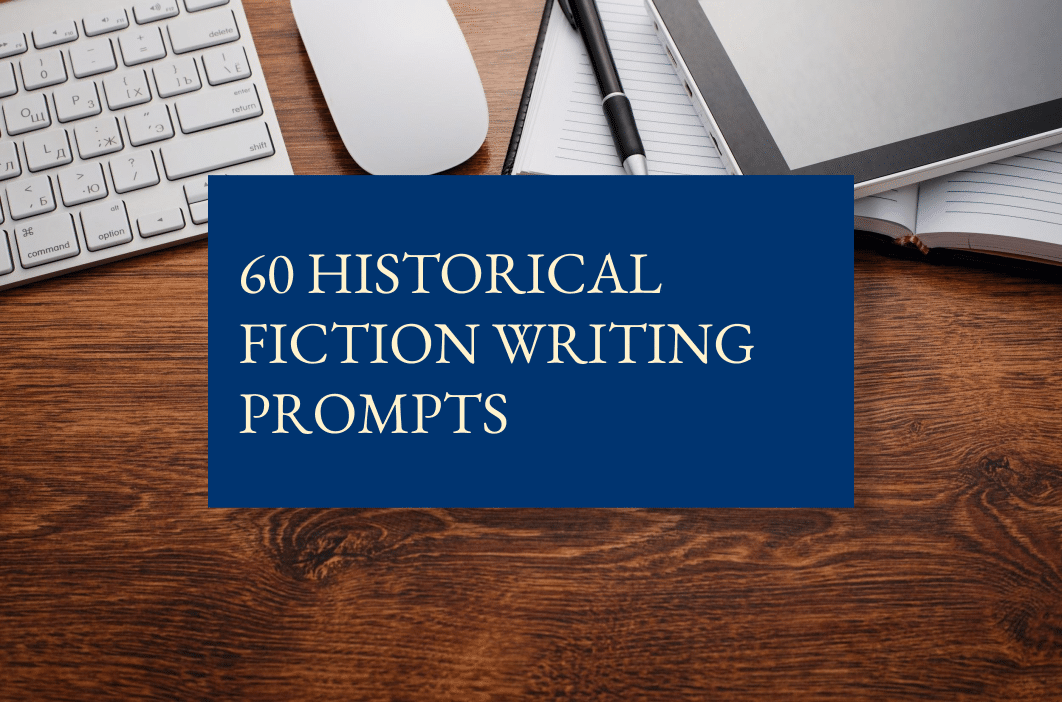
We’re delighted to share this list of 60 historical fiction writing prompts to inspire your creative writing. We’ve put them on a historical timeline, starting in 399 BCE and ending in 1969. They cover a range of periods, places, and situations. Feel free to adapt them in any way you like. Enjoy!
You are one of the jurors at the trial of Socrates, who is accused of corruption and impiety. After the verdict, argument ensues about an appropriate punishment. You are arguing against the death penalty, but those around you seem determined to impose it. What happens next?
In Constantinople, the emperor Constantine decrees that Christians must cut all ties with their Jewish heritage or face execution. What does this mean for you and your family? How do you react to this new law? What do you choose to do?
You are walking out on the clifftop, and you see a fleet of Viking ships on the horizon. As you watch, you realise they are heading towards the coast. What happens next?
You are a member of Macbeth’s household. When King Duncan is killed, you realise that everything is changing around you. What do you do? Do you stay loyal to Macbeth, or do you leave and join those who oppose him?
50+ top online research resources for historical fiction writers
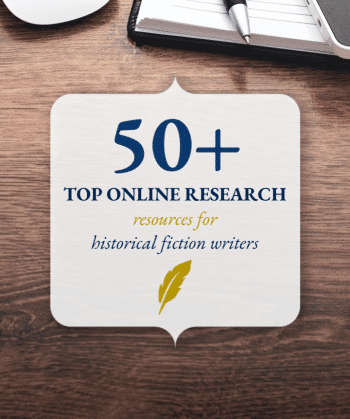
Writing guides
How to write historical fiction in 10 steps
Top tips on writing historical fiction from 64 successful historical novelists
10 essential research tips for historical fiction writers
Beta reader service
Get feedback on your novel from real historical fiction readers.
ARC service
Use our ARC service to help generate reviews for your book.
Top resources
Guide to accuracy and authenticity in historical fiction
Novel outline template for historical fiction writers
How to write a query letter
Featured blog posts
30 top historical fiction literary agents
How to write flashbacks
When (and how) to use documents in historical fiction

75 Historical Fiction Writing Prompts to Inspire You

Table of Contents
Explore the depths of the past with our list of 75 Historical Fiction Writing Prompts. Ignite your creativity and embark on a journey through time with compelling story ideas that bring history to life. Perfect for writers seeking inspiration for their next historical masterpiece.
Ancient World
Stepping into the realms of the ancient world offers a unique opportunity to weave narratives steeped in the mysteries and marvels of bygone eras. Whether you’re looking to craft tales of pharaohs’ curses, Spartan warriors, the philosophical minds of Athens, or the formidable legions of Rome, the ancient world is ripe with stories waiting to be told. As a writer, you possess the power to resurrect lost civilizations and breathe life into their stories through your words. Below, you’ll find a curated collection of ancient world writing prompts, each a spark to ignite the imagination and transport readers back to the dusty pages of history where legends were born and epic sagas unfolded. So sharpen your quill (or stylus) and prepare to embark on a literary odyssey that transcends time.
- The Lost Scroll: A scribe in ancient Alexandria finds a scroll that could change history.
- The Gladiator’s Dilemma: A Roman gladiator earns his freedom but at a cost to his honor.
- Spartan Secrets: A Spartan warrior’s loyalty is tested on the eve of battle.
- Pharaoh’s Shadow: A servant in the Pharaoh’s palace uncovers a plot against the ruler.
- The Oracle’s Whisper: An oracle in Delphi receives a prophecy that could start a war.
Medieval Times
The medieval era, a tapestry rich with the chivalric code of knights, the silent whispers of castles, and the tumultuous shifts of power, offers a wellspring of narrative potential for any writer. It is a time where myth intertwines with the harsh truths of life, where dragons could be slain and kingdoms could rise or fall based on the whims of fate. This collection of medieval writing prompts invites you to don your literary armor and charge into the fray of storytelling. From the misty highlands of Scotland to the grand courts of Byzantine emperors, let each prompt guide you through the shadowed forests of history to the very heart of the Middle Ages. Here, amongst the echoes of crusaders’ calls and minstrels’ songs, you might just find the inspiration for your next great tale, one quill stroke at a time.
- The Silent Bard: A mute musician witnesses a royal murder in medieval France.
- The Alchemist’s Apprentice: An alchemist’s apprentice discovers the secret to turning lead into gold.
- The Heretic’s Library: A scholar in the Spanish Inquisition hides forbidden books.
- The Crusader’s Vow: A knight on the Crusades questions his faith.
- The Plague Healer: A herbalist in a plague-ridden village has a cure that could save or condemn her.
Age of Exploration
As dawn broke over the Age of Exploration, a new chapter in the annals of history was penned, marked by the creak of timber, the billow of sails, and the whisper of the ocean guiding explorers to unknown horizons. This epoch, rife with discovery and peril, is a fertile ground for storytellers drawn to the siren call of adventure and the promise of the uncharted. Our collection of writing prompts beckons you to navigate the high seas of your imagination, to chart a course through tempests and stars, and to recount the tales of intrepid voyagers who sought new lands, treasures, and truths. Embark on a voyage through your prose, and capture the spirit of conquistadors, the ingenuity of cartographers, and the bravery of those who dared to dream beyond the map’s edge. Let these prompts be your astrolabe, guiding you through the storied waters of the Age of Exploration, where every point on the compass leads to narrative possibilities as vast as the Atlantic itself.
- The Mapmaker’s Conspiracy: A cartographer in the Age of Exploration finds a map to a new world.
- The Stowaway’s Journey: A stowaway on Magellan’s fleet encounters unknown lands.
- The Merchant’s Gamble: A spice merchant in Renaissance Venice risks everything on a new trade route.
- The Conquistador’s Regret: A conquistador in the New World confronts the consequences of his quest for gold.
- The Pirate’s Code: A pirate is torn between the freedom of the sea and the love left behind.
Colonial & Revolutionary Eras
In the shadows of Colonial and Revolutionary times, a fierce wind of change began to stir, a prelude to the thunderous revolution that would shake the foundations of empires and give birth to new nations. This era, a crucible of innovation, ideology, and insurrection, is a goldmine for those who dare to delve into its complex heart through the art of storytelling. Our trove of writing prompts invites you to step onto the cobblestone streets of colonial towns, to eavesdrop on the secret meetings of revolutionaries, and to witness the forging of foundational documents that would forever alter the course of history. As you take pen to paper, let your narratives be infused with the cries for liberty, the smoke of musket fire, and the silent, steely resolve of those who fought in the shadows and in the spotlight for a future they believed in. Through your words, the echoes of the Colonial and Revolutionary Eras can resound anew, telling tales of sacrifice, of unyielding hope, and the relentless pursuit of freedom that defined these tumultuous chapters of history.
- The Witch’s Advocate: A lawyer in Salem tries to save the accused during the witch trials.
- The Rebel’s Message: A spy during the American Revolution carries a message that could turn the tide of war.
- The Loyalist’s Dilemma: A British loyalist in America struggles with their allegiance as revolution brews.
- The Queen’s Colony: A member of the first colony in Australia uncovers a royal secret.
- The Duel’s Witness: A young man witnesses a duel that changes the fate of a nation.
19th Century Intrigue
The 19th century: an era of stark contrasts where the gas-lit streets of progress and the shadows of intrigue walked hand in hand. This was a time when the whispers of revolution still lingered in the air, and the clatter of the Industrial Revolution’s gears heralded a new age of possibility. Our collection of writing prompts dips its quill into the inkwell of a century alive with the undercurrents of political conspiracies, the early cries for social reform, and the elegant, often cutthroat, machinations of high society. Let these prompts guide you through drawing rooms and factories alike, into the lives of inventors, poets, and rebels. Craft narratives that capture the smog and the splendor, the corsets and the coal mines, the locomotives and the literature that characterized this period of ceaseless transformation. In the 19th century’s tapestry, every thread tells a story of discovery and deceit, a personal tale against a backdrop of burgeoning empires and fading aristocracies. Through your storytelling, bring to life the subtle dances of diplomacy and the loud declarations for change, all under the watchful eyes of Victorian propriety and the relentless pursuit of progress.
- The Industrialist’s Discovery: An inventor during the Industrial Revolution creates a machine that could alter the course of history.
- The Abolitionist’s Mission: An abolitionist in the antebellum South smuggles slaves to freedom.
- The Empress’s Assassin: An assassin in the court of Napoleon III has a change of heart.
- The Gold Rush’s Hidden Treasure: A prospector in the California Gold Rush finds much more than gold.
- The Outlaw’s Honor: An infamous outlaw in the Wild West encounters an old love.
Wars of the 20th Century
The 20th century was a time scarred by the fury of war, an age that witnessed the world in tumult, from the trenches of the Great War to the shattering advances of the atomic age. In this era of conflict, humanity’s greatest tales of heroism and horror unfolded, where every soldier’s story was a chapter, and every battlefield a brutal verse in the saga of the century. Our writing prompts plunge you into the heart of these wars, asking you to chronicle the human spirit amidst the chaos of battle, the silence of a ceasefire, and the bittersweet returns to peace. These prompts encourage you to explore the personal amidst the universal, the individual emotions that played out against the vast canvas of global conflict.
Through your words, traverse the muddy, blood-stained grounds of No Man’s Land, the cryptic corridors of espionage, and the home fronts charged with anxious hope and sacrifice. Your tales can give voice to the unspoken bonds of brotherhood in the trenches, the quiet strength in the face of loss, and the resilience needed to rebuild in war’s wake. As you tell stories of the 20th century’s wars, reflect on the echoes of battle cries and peace songs that shaped our modern world, and remember the countless lives marked by those deafening salvos of change.
- The Soldier’s Letter: A soldier in World War I writes a letter home that holds a secret.
- The Spy’s Opera: A spy in World War II uses an opera performance as a cover for espionage.
- The Refugee’s Journey: A refugee during the Vietnam War seeks a new life in America.
- The General’s Decision: A general in the Korean War faces a moral quandary.
- The Protester’s Dream: A civil rights activist in the 1960s fights for equality.
Modern Historical Events
In the ever-accelerating rush of modern history, events cascade one after the other, shaping and reshaping the contours of the present. From the fall of the Berlin Wall to the digital revolution, the turn of the millennium has been anything but quiet. Your pen stands ready to sketch the stories of this rapidly changing landscape, where every headline has the potential to become a pivotal moment in someone’s life. These writing prompts invite you to explore the personal stories intertwined with public records, to navigate the complexities of a world more connected than ever before.
You have the opportunity to animate the tales of unsung heroes in the wake of natural disasters, to decode the human emotions behind technological breakthroughs, and to paint the picture of global unity in the fight against pandemics. The modern era, with its blend of breakthroughs and breakdowns, its chorus of diverse voices striving for progressamid echoes of past struggles, is your canvas.
Dive into the nuanced layers behind the 24-hour news cycle, where every individual is both an observer and a participant in the march of history. Through your narratives, bring forth the essence of modern historical events — the fear, the hope, the ambition, and the striving for a tomorrow that is always just one day away.
- The Wall’s Whisper: A citizen in Berlin during the Cold War hears secrets through the wall.
- The Diplomat’s Crisis: A diplomat during the Cuban Missile Crisis navigates treacherous negotiations.
- The Journalist’s Scoop: A journalist uncovers a scandal during the Watergate investigation.
- The Survivor’s Memory: A survivor of 9/11 copes with the memories and loss.
- The Rebel’s Graffiti: An artist during the Arab Spring uses graffiti to spread revolutionary messages.
Future Historical Fiction
The realm of future historical fiction is a paradoxical tapestry, weaving together the threads of tomorrow’s history with the imagination of today. It’s a genre that invites writers to dream up the potential legacies of our time, casting shadows of what might be onto the blank slates of worlds yet to come. These writing prompts beckon you to envision the milestones of the future, from the first colonies on Mars to the deep sea cities of Earth, from the peace treaties signed with artificial intelligence to the cultural revolutions sparked by technologies unborn.
As a chronicler of future histories, you hold the power to mold the narrative of the next century and beyond, to speculate on the outcomes of current global challenges, and to infuse your stories with the hopes, dreams, and fears that define the human condition. Will you tell of the day when climate change was finally reversed? Of the moment when humanity first made contact with another sentient race among the stars? Or perhaps you’ll chart the moral dilemmas faced by our descendants as they blend their biology with machines.
In this uncharted territory, your words become the prophecies and legends of generations yet to be, painting vivid pictures of what might come to pass. Embrace the freedom of future historical fiction, where the facts are yours to create, and history’s yet unwritten pages are waiting for your imagination to bring them to life.
- The Colonist’s New World: A colonist on Mars uncovers the ruins of an ancient civilization.
- The Time Traveler’s Paradox: A time traveler to the future must ensure their own history remains unchanged.
- The Geneticist’s Dilemma: A geneticist creates a cure for aging, but at what cost to society?
- The Climate Engineer’s Gamble: A scientist tries to reverse global warming but unleashes a new threat.
- The AI’s Awakening: An AI becomes sentient and leads a robot revolution.

Diverse Perspectives & Untold Stories
In the vast expanse of human history, there are countless narratives that have been overshadowed or left untold, whispers of lives and dreams that didn’t find their way into the pages of widely read history books. The genre focusing on diverse perspectives and untold stories seeks to illuminate these hidden corners, offering a voice to the voiceless and shading in the areas that mainstream narratives have left blank. These writing prompts challenge you to step into the shoes of those who walked unseen, to share the tales of individuals and communities that history has overlooked.
As you embark on this storytelling journey, consider the perspectives of those who have historically been marginalized: the stories of women who spurred silent revolutions, the narratives of indigenous peoples preserving their heritage against the tide of colonization, or the personal triumphs and trials of individuals within the LGBTQ+ community. Imagine the courage of those who fought for equality and recognition in a world that often denied them both.
This is your chance to rewrite the narrative, to bring color and context to the monochrome renditions of our past, and to celebrate the rich tapestry of human diversity. Through your tales, let readers witness the world through the eyes of those who have lived on the periphery, whose every day was a testament to resilience and whose legacies deserve to be remembered and revered. In the unearthing of these untold stories, you can shine a light on the myriad hues of the human experience, fostering empathy and understanding across the boundaries that have divided us.
- The Translator’s Secret: A translator for the United Nations uncovers a conspiracy.
- The Immigrant’s Keepsake: An immigrant’s journey to Ellis Island with a family heirloom.
- The Samurai’s Disgrace: A samurai in feudal Japan is forced to become a ronin.
- The Courtesan’s Court: A courtesan in ancient China navigates the deadly politics of the Emperor’s court.
- The Freedom Fighter’s Promise: A freedom fighter in apartheid-era South Africa makes a fateful promise.
Romantic Epochs
The Romantic Epochs whisper to us of an age where passion was penned in ink and love was a grand affair, played out against the backdrop of history’s most poignant moments. This genre invites you to unfurl the scrolls of time and inscribe new tales of ardor where the heart’s desires meet the turning points of the past. Your writing prompts are keys to unlock the gilded cages of regal courts, to waltz through the candlelit ballrooms of the Belle Époque, or to steal away into the secret trysts amidst the Renaissance’s rebirth of art and culture.
In crafting narratives of romantic epochs, you are tasked with dressing love in the finest historical garments, be it in the hidden love letters of war-torn lovers or the forbidden glances in the strict societal hierarchies of the Victorian era. The characters you create live and love under the weight of their time’s customs and the expectation of decorum, all while their hearts beat to the timeless rhythms of desire, devotion, and defiance.
Let your prose dance to the music of bygone days, where each romantic entanglement is a reflection of the epoch’s soul, and every whispered promise under the moonlit sky is a thread in the tapestry of history. Your stories are an homage to the lovers of yesteryears, a celebration of how the human heart finds its counterpart in another, transcending the bounds of time and history to tell a tale as old as humanity itself – the tale of love.
- The Poet’s Muse: A poet in the Romantic era is inspired by a mysterious muse.
- The Heiress’s Rebellion: An heiress during the Gilded Age falls for a man deemed beneath her.
- The Soldier’s Return: A World War II soldier returns home to a lover who thought him dead.
- The Flapper’s Secret: A flapper in the Roaring Twenties hides a dangerous connection to organized crime.
- The Bard’s Lost Play: A playwright in Elizabethan England writes a play that could destroy him.
Cultural Revolution
The term “Cultural Revolution” conjures images of seismic shifts in the social fabric, of eras where the very foundations of society were shaken by the collective yearning for change. Within these tumultuous waves of transformation, lie stories ripe for the telling—stories of upheaval, of radical reimagining, of brave new voices rising up to challenge the status quo. Writing prompts that delve into Cultural Revolutions invite you to portray the fervor and frenzy of these times, the intimate revolutions within public upheavals.
Envision the defiant artist in the midst of a society turning its back on centuries-old traditions, or the solitary thinker whose ideas ignite the flame of change. Picture the streets alive with the spirit of reform, the silent evolution within homes, and the loud declarations in public squares. As you pen tales of cultural metamorphosis, you become a chronicler of change, documenting the struggle between the old guards and the new pioneers, capturing the moment when the zeitgeist shifts and a new era is born.
Your narratives can explore the spectrum of human emotion that accompanies such profound changes: the exhilaration, the fear, the sense of purpose, and the pangs of loss for what is left behind. From the Renaissance to the Roaring Twenties, from the countercultural 1960s to the digital explosion at the turn of the millennium, each epoch provides a playground for stories of individuals and societies forging new identities.
In the throes of a Cultural Revolution, every act is a statement and every day is a page in history. Your writing can breathe life into these pages, inviting readers to experience the rebirth of culture, to feel the pulse of the times, and to witness the drama of humanity redefining its destiny.
- The Beatnik’s Road: A beatnik on a cross-country journey in the 50s seeks enlightenment.
- The Hippie’s Protest: A hippie during the Summer of Love tries to stay true to their ideals.
- The Punk’s Anarchy: A punk in the 70s London grapples with the movement’s growing violence.
- The Dancer’s Escape: A dancer in Soviet Russia defects during a cold war tour.
- The Activist’s Choice: An environmental activist in the 90s faces a life-altering decision.
Shadows of the Past
In the genre that explores the Shadows of the Past, the whispering echoes of bygone eras become the backdrop for narratives steeped in the mysterious and the overlooked. These writing prompts call upon you to delve into the dim corners of history, to dust off the forgotten, and to cast light upon the secrets that have slumbered through time. Here, the past is a haunting presence, a silent character that influences every twist and turn of your tale.
Imagine the weight of ancestral secrets on the shoulders of a modern protagonist, the discovery of a hidden diary revealing unwritten history, or the unraveling of a legacy that has cast a long shadow over a family’s lineage. Perhaps your story might explore the ruins of an ancient civilization, breathing life into the myths that have lingered like mist through centuries or the excavations that unearth relics that challenge the accepted narratives of our forebears.
These prompts invite you to become an archaeologist of the intangible, excavating not artifacts but stories, not treasures but truths long buried. Your words will dance with the ghosts of the past as you weave narratives that bridge the gap between then and now, showing how the echoes of yesteryear still reverberate in our present, shaping our lives in myriad unseen ways.
Crafting tales within the Shadows of the Past, you offer a rendezvous with history’s enigmas and give a voice to the tales that time has tried to silence. It’s a chance to speculate, to dream, and to ponder the ‘what ifs’ and ‘might have beens,’ all while captivating your readers with a suspenseful tug at the veils of antiquity.
- The Healer’s Trial: A medieval healer is accused of witchcraft when the plague comes to her village.
- The Maiden’s Voyage: A young woman on the Titanic seeks adventure but finds romance.
- The Inventor’s Rivalry: An inventor in the Renaissance competes with a rival, leading to unexpected consequences.
- The Miner’s Fortune: A miner during the Klondike gold rush makes a fortune but loses his soul.
- The Architect’s Blueprint: An architect in Ancient Rome designs a revolutionary aqueduct.
Turn of the Century
The turn of the century, that pivotal moment where one era’s final pages give way to the fresh chapter of another, is a time ripe with both trepidation and excitement. It is a period that stands at the crossroads of progress and tradition, where the gaslights begin to dim and the electric bulb flickers to life. Your writing prompts beckon you to explore these transitional days, to capture the spirit of an age on the cusp of the modern world.
Imagine the swirl of Victorian skirts giving way to the Roaring Twenties’ flappers, the clatter of horse-drawn carriages overtaken by the chugging of the first automobiles. Picture a society enthralled by the wonders of the World’s Fair, yet clinging to the cobblestone romance of the century’s twilight. This epoch is a banquet for narrative, offering a taste of the old world and the first bite of the new.
In your stories, characters might wrestle with the rapid pace of technological innovation, or they might embrace the burgeoning movements that would define the 20th century—women’s suffrage, labor reform, artistic modernism. The air is thick with change, each day a brush stroke on the canvas of time, painting a picture of an age that looks back for a brief moment only to leap forward into the future.
Crafting tales at the turn of the century, you have the power to encapsulate the magic and the uncertainty of an age that believed in the promise of tomorrow. Your words can reflect the brilliance of innovation as well as the nostalgia for days fading into the shadows, capturing the delicate dance between the dusk of one epoch and the dawn of another.
- The Suffragette’s Sacrifice: A suffragette in the early 1900s makes a controversial choice for her cause.
- The Conductor’s Symphony: A conductor in 1930s Berlin hides his opposition to the regime through music.
- The Farmer’s Struggle: A farmer during the Great Depression fights to keep his land and family together.
- The Bootlegger’s Legacy: A bootlegger during Prohibition has a crisis of conscience.
- The Aviator’s Dream: An aviator in the 1920s attempts to fly non-stop around the world.
Conflict and Resolution
“Conflict and Resolution” offer the quintessential pulse of narrative—the heart and soul of drama in the theater of human history. Writing prompts centered on this theme invite you to navigate the stormy seas of discord, the fervent clash of ideologies, and the personal battles that define the human experience. Here, you have the stage to set characters against each other, against society, or against themselves, in stories where the tension is palpable and the outcomes are uncertain.
Picture the heady rush of revolutionary fervor challenging an empire, or the quiet, internal struggle of a protagonist coming to terms with an unalterable truth. Envision the fierce battles of wills, the war of words in parliamentary debates, or the silent war within a heart caught between love and duty. These stories are as varied as they are intense, ranging from the personal to the political, from the courtroom to the battlefield.
In crafting narratives of conflict, you can delve into the essence of what it means to strive for something, to grapple with opposing forces, whether they be armies, principles, or inner demons. And within resolution, you find the aftermath, the peace that is often complex and fraught with the residue of battle, the reconciliation of relationships, or the bittersweet acceptance of change.
Your stories can offer catharsis, drawing readers through the fiery crucible of confrontation and into the soothing balm of resolution. They are a testament to the resilience of the human spirit, a chronicle of how, despite all odds, equilibrium is sought—be it through victory, compromise, or an understanding that some conflicts leave indelible marks that shape us forever.
In the dance of conflict and resolution, your pen becomes a sword and a salve, cutting deep to reveal truths and writing the ointment that heals the incisions of human struggle. It’s a powerful theme that resonates with the core of human storytelling, from ancient epics to modern dramas, reflecting our eternal quest for harmony in the symphony of life.
- The Negotiator’s Gamble: A negotiator during the Northern Ireland peace talks faces personal and political challenges.
- The Resistance’s Last Stand: A member of the French Resistance during WWII stages a daring operation.
- The Spy’s Defection: A Cold War spy decides to defect, risking everything for freedom.
- The Warrior’s Homecoming: A returning Crusader finds his home village drastically changed.
- The Diplomat’s Secret: A diplomat in ancient China carries a message that could stop a war.
Artistic Endeavors
“Artistic Endeavors” serve as a vibrant canvas for the imagination, celebrating the creative spirit that drives individuals to express the inexpressible through their craft. Writing prompts in this vein beckon you to explore the fervent passion of the artist and the transformative power of art itself. This theme invites narratives filled with color, texture, and the intricate dance between inspiration and the arduous journey to creation.
Envision the solitary painter who whispers secrets into every stroke of the brush, or the musician whose melodies carry the weight of unspoken dreams. Picture the sculptor whose chisel frees forms from stone, or the writer whose words birth worlds from the void. Each story becomes a tribute to the labor of love that is art, the sacrifices made at its altar, and the impact it leaves upon the world and its creator.
Within these tales, you can delve into the struggles that accompany the act of creation—the doubt, the frustration, the exhilarating moments of breakthrough, and the fear of obscurity. The characters may grapple with the demands of their genius, the misunderstandings of a society that often values art less than it does more tangible achievements, or the transcendent joy of a moment of pure, unadulterated expression.
Your stories will not only showcase the artists’ journey but also highlight art’s influence on the observer, the community, and epochs of culture. Artistic Endeavors allow you to paint with words, capturing the essence of what it means to be driven by a force that is at once deeply personal and universally resonant.
Crafting narratives around Artistic Endeavors, you illuminate the myriad ways in which art reflects and shapes the human condition, how it can be both a solitary and a shared experience, and how, through the act of creation, we leave indelible marks upon the canvas of our shared humanity.
- The Painter’s Canvas: A painter during the Renaissance is commissioned for a portrait that holds a secret.
- The Sculptor’s Model: A sculptor in Ancient Greece falls in love with their own creation.
- The Musician’s Melody: A musician in 18th-century Vienna composes a symphony that alarms the monarchy.
- The Playwright’s Gambit: A playwright in Elizabethan England pens a play critical of the crown, disguised as a comedy.
- The Dancer’s Challenge: A ballerina in post-war Paris must choose between her career and a forbidden love.
These 75 historical fiction writing prompts offer a gateway into the rich tapestry of the past, allowing us to explore forgotten eras, untold stories, and the lives of those who came before us. Through these prompts, we can step into the shoes of historical figures, witness pivotal moments in history, and reimagine events through the lens of fiction. Each prompt holds the potential to transport us to a different time and place, to ignite our imaginations, and to unveil the hidden truths and complexities of the human experience. So, pick up your pen and embark on a journey through history, where the past comes alive and the stories of our ancestors are waiting to be told.
Mastering the Drafting Process of Writing: A Foolproof Method for Aspiring Authors
The ultimate list of action verbs:.
When it comes to writing, Willow Tenny is a true pro. She has a wealth of experience in SEO copywriting and creative writing, and she knows exactly what it takes to produce quality content. On her blog, Willow Writes, Willow shares top writing strategies with both beginners and experienced writers.
Related Posts

Journal Prompts: 75 Prompts for 2023
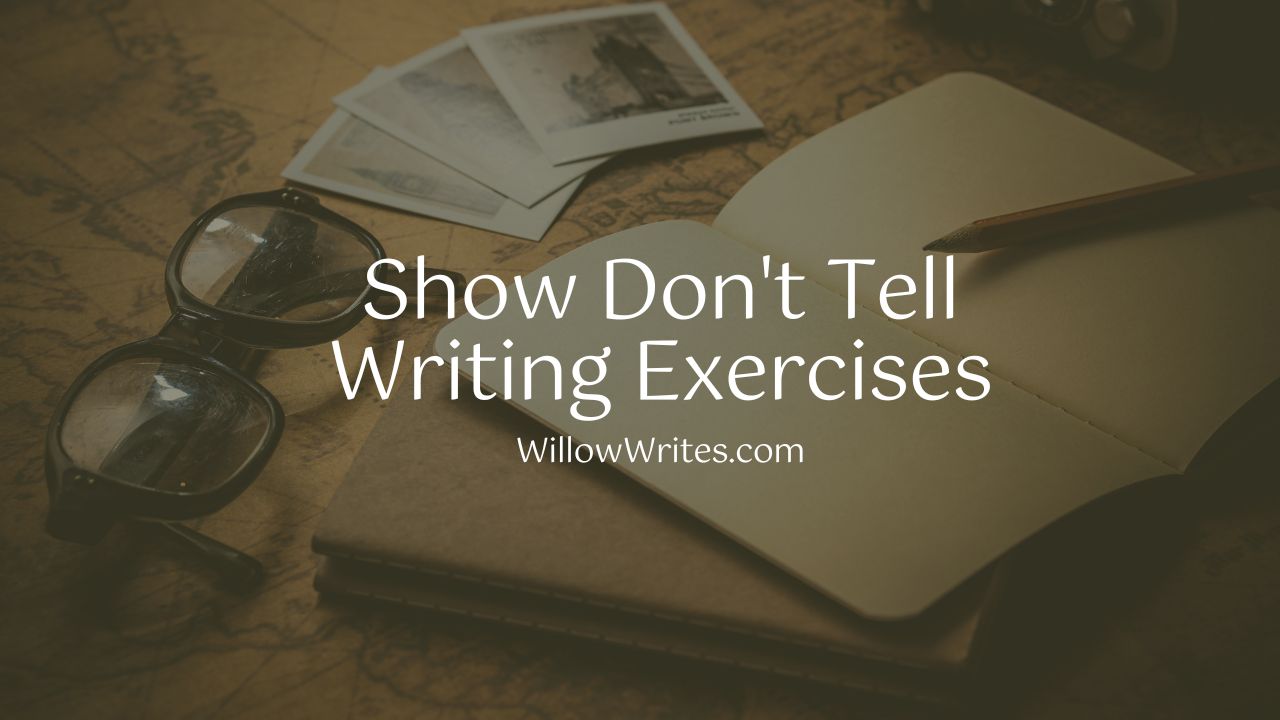
Show Don’t Tell Writing Exercises: How To
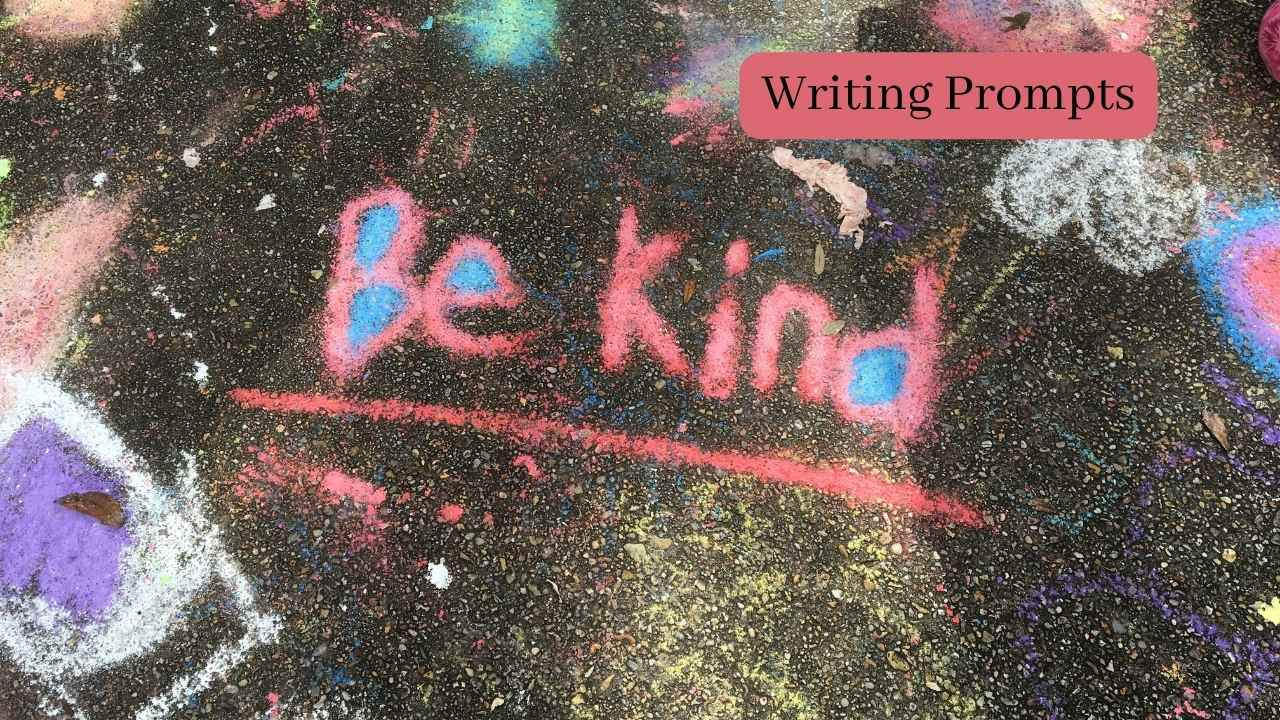
50 Kindness Writing Prompts to Unleash your Inner Writer

Leave a Reply Cancel reply
Your email address will not be published. Required fields are marked *
Save my name, email, and website in this browser for the next time I comment.
- AI Writing (7)
- Angel Numbers (1)
- Publishing (3)
- Spirituality (1)
- Writing Jobs (6)
- Writing Prompts (4)
- Writing Tips (43)
- Writing Tools (3)
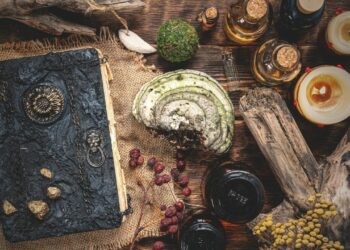
So Mote It Be: A deeper look into the meaning and usage of this phrase.

How to Write in 3rd Person About Yourself

Conversational Style Writing Examples
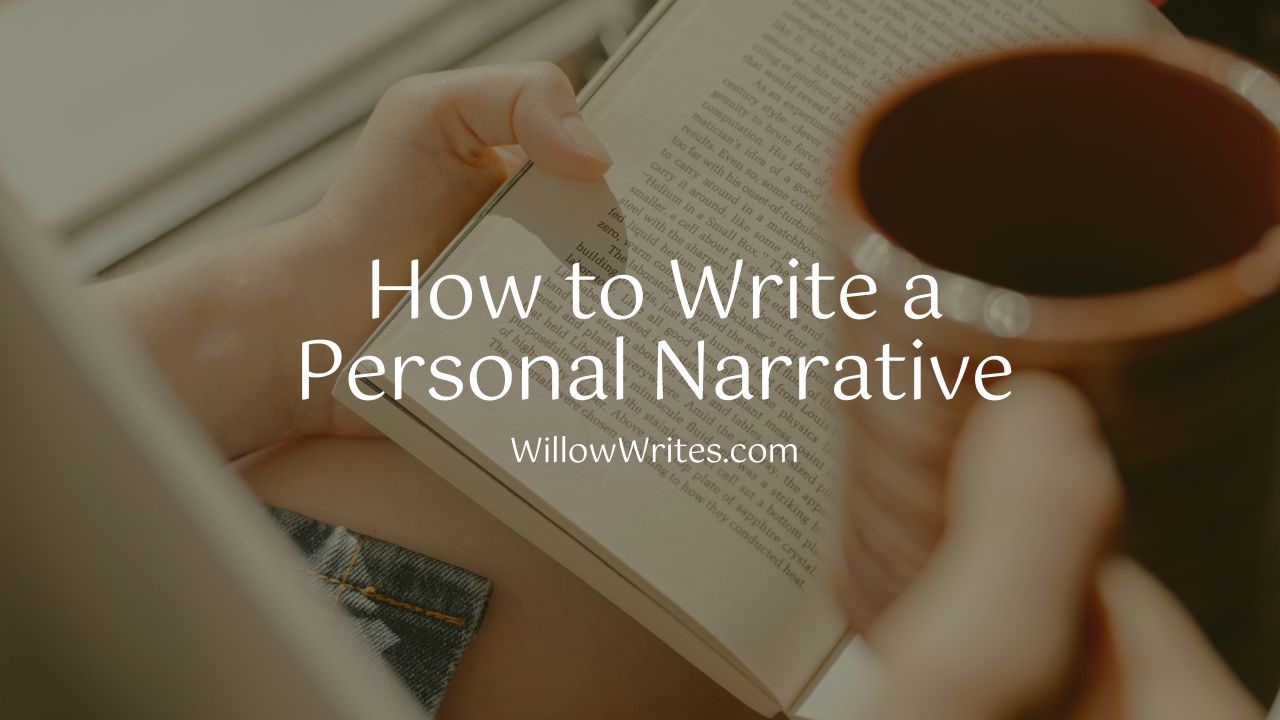
How to Write a Personal Narrative [in 10 Easy Steps]
- Writing Tips
Researching the Victorian Era

Writers Can Watch TV and Call It Work
There’s a joke I’ve seen on Pinterest, a cartoon of a writer watching TV. The character says, “I’m researching!” to the cynical-looking people standing nearby. For those of us who write fiction, we know that watching TV or movies, listening to music, or going for walks really is research because all of it becomes part of the writing process.
Writers, especially fiction writers, need their imagination fueled regularly, and it’s the little things we do, such as stealing an hour here or there to watch a favorite TV show or listen to our favorite music, that help to fill the creative well so that we have a brain full of ideas when we sit down to write.
When it comes time to write, especially if I’m writing a historical story, I try to immerse myself in the time period as much as possible. If I feel as if I’ve traveled back in time, then it’s easier for me to carry my readers along with me on the journey.
I loved writing historical fiction set during the Victorian era. Here are some of the places I found inspiration while writing my sweet Victorian Downton Abbey inspired romance, When It Rained at Hembry Castle . My hope is that by reading over my list, other writers of historical fiction will discover places to find inspiration of their own.
Nonfiction Books That Inspired My Sweet Victorian Romance

What Jane Austen Ate and Charles Dickens Knew by Daniel Pool
How To Be a Victorian: A Dusk-to-Dawn Guide to Victorian Life by Ruth Goodman (one of my new favorite historians—she lives what she studies)
The Victorian City: Everyday Life in Dickens’ London and Inside the Victorian Home: A Portrait of Domestic Life in Victorian England by Judith Flanders
The Writer’s Guide to Everyday Life in Regency and Victorian England From 1811-1901 by Kristine Hughes
To Marry an English Lord by Gail MacColl and Carol McD. Wallace
Below Stairs: The Classic Kitchen Maid’s Memoir That Inspired “Upstairs, Downstairs” and “Downton Abbey” by Margaret Powell
The Essential Handbook of Victorian Etiquette by Thomas E. Hill
Novels That Inspired My Sweet Victorian Romance
When reading novels, I look for books written during the era I’m writing about as well as novels written about the era. Other times I’ll find inspiration in a novel that isn’t necessarily set in that time period but there’s something about the story that provides some ideas.

Snobs by Julian Fellowes
The Remains of the Day by Kazuo Ishiguro
I read A LOT of P.G. Wodehouse (but really, can you read too much Wodehouse?)
I read A LOT of Dickens (but really, can you read too much Dickens?)
Wolf Hall and Bring Up the Bodies by Hilary Mantel (set in the Tudor era—I know—but she’s such a master of historical fiction I needed to read the books again)
TV and Film That Inspired My Sweet Victorian Romance
For me, TV and film are the same as fiction—some of what I watch is set in the era, some is not, but all stir my imagination in one way or another.
Downton Abbey (Surprised, right?)
Upstairs, Downstairs
The miniseries of The Buccaneers
North and South
Lark Rise to Candleford
Pride and Prejudice (Colin Firth’s version)

I tried to watch the TV versions of Bleak House and Great Expectations , but to be honest screen adaptations of Dickens’ work rarely thrill me. They get the drama down all right, but you’d never guess Dickens was one of the funniest authors in the English language from the dreariness of the adaptations. I’m doing a little better with Dickensian , if for nothing else but Stephen Rea’s performance as Inspector Bucket.
Keeping Up Appearances— Another Bucket (It’s BooKAY).
Miss Fisher’s Murder Mysteries —this outstanding Australian show is set in the 1920s, but I love Essie Davis’ Phryne Fisher so much I’ll use any excuse to watch it. Phryne Fisher’s clothes are even more fabulous than the costumes on Downton Abbey .
Listening to Victorian Era Music
Since my Victorian story is set in the 1870s, people were dancing to waltzes and polkas. Strauss and Chopin were favorite composers, which works well for me since I love to listen to classical music.

Here are a few examples of what I found:
Victorian Dining by Peter Breiner and Don Gillis
Victorian Edwardian by Alexander Faris
Victorian Love Songs by Craig Duncan
If you’re writing historical fiction, I highly recommend listening to music from the era while you write. I find a lot of great songs on Amazon, and if you have Amazon Prime then you can listen to some of the music for free.
Pinterest Can Be a Good Source of Historical Inspiration
I adore Pinterest. For me, Pinterest isn’t social media as much as something I do for fun because I love it so much. When It Rained at Hembry Castle is the first novel I’ve written since I started on Pinterest, so it’s the first time I was able to use pictures from the site to inspire my writing.
When I needed to describe the sitting room at Hembry Castle, for example, I simply needed to go onto my research board, find the pin for the photograph I wanted to use as inspiration, and describe what I saw. If you’re writing your novel on Scrivener, you can import those photos directly into your novel file so they’re readily available when you need them.
When I was researching the novel, I created a private board for Hembry Castle because I didn’t want to bombard my followers with my many research pins. Then, when I had everything I needed, I created a public board so people could see the inspiration behind the story. Want to check out the board? It’s here.
Travel Can Be a Good Source For Writing Inspiration
I had a few things to say about traveling for research purposes in this post. Of course, it’s not always possible to travel, but if you can then do.
London, England: I’ll have more to say about my journeys to London for research purposes in a later post. For now, I’ll say that London is always a good idea.

Pittock Mansion in Portland, Oregon
Portland, Oregon: An odd place to travel when researching a novel set in Victorian England, I know. I didn’t actually travel there for that purpose, but when I arrived I found Pittock Mansion, an American, smaller-scale version of an English country house.
Pittock Mansion provided a lot of inspiration for Hembry Castle. In fact, the music room and the library in Hembry Castle were modeled after rooms in Pittock Mansion.
What Does Your List of Creative Inspirations Look Like?
This is just the short list of places where I found inspiration for my Victorian historical novel. I hope you’ve discovered a few ideas for places you might seek inspiration for your own historical stories, whichever era they’re set in.
Thanks for sharing!

Vibrant Victorians
A collection of creative writing tasks inspired by ten early silent films.
This series of starter activities uses a range of silent films from the Victorian era as prompts for creative writing tasks. An illustrated presentation, featuring information about the films, discussion points and writing prompts, is provided for each film.
Lesson resources
Royal proclamation of death of queen victoria, blackburn (1901).
Crowds gather outside the Town Hall to hear the town crier’s royal announcement.
Snowballs (1901)
Young scamps launch a snowball attack on a hapless bobby.
The Funeral of Queen Victoria (1901)
The crowds stand silent as the nation says goodbye to Queen Victoria in February 1901.
Manchester Spiritualists Procession (1901)
Exponents of Britain's newest religion don their Sunday best for a parade through Edwardian Manchester.
Arrest of Goudie (1901)
Crimewatch Mitchell and Kenyon style, in the first ever film to recreate a true crime.
Return of the Royal Warwickshire Regiment (1901)
Soldiers returning from the Boer War get a warm welcome home from crowds in Edwardian Birmingham.
York Road Board School, Leeds (1901)
A small battalion of Yorkshire schoolchildren lines up for a playground photograph.
Workforce of Haslam’s Ltd., Colne (1900)
Lancashire mill-workers have fun in front of the camera.
Santa Claus (1898)
G.A. Smith’s film uses pioneering visual effects in its depiction of a visit from St. Nicholas.

Creative Writing Club – members' area
² navigation, write your own story – victorians.
Queen Victoria’s reign was an age of inventions and inequality, railways and rat pits, soldiers and suffragettes, Christmas trees and criminals… you get the picture. Let’s write a Victorian epic.

⊕ Go through the steps below to create your story...
1. Choose two Victorian locations:
- gentleman’s club
- Whitechapel High Street
- Fleet Street
- match factory
- the workhouse
- the baby farm
The workhouse was a place where people too sick or poor to support themselves went to work (in return for food and a place to sleep). A 'baby farm' was a place where unmarried mothers send their babies - so they could go out and work.
2. Choose two characters to be in the story:
- Jack the Ripper
- Sherlock Holmes
- Sweeny Todd (the demon barber)
- Florence Nightingale
- Amelia Dyer (the baby farmer)
- the ‘peelers’ (policemen)
- a rat catcher
- a match girl (factory worker)
The first three names - Sherlock, Jack and Sweeny - are fictional characters..
3. Choose two objects for your story...
- secret letter
- poison (arsenic)
- bottle of medicine
- gold sovereigns
- Choose your own idea
4. Write the story from the most exciting part.
If you are working with a partner - write one line each.

Victorian Literature: Topics in Victorian Literature
- Research Skills
- General Resources
- Bronte Sisters
- Charles Dickens
- George Eliot
- Thomas Hardy
- Topics in Victorian Literature
- Academic Writing This link opens in a new window
- Citing Sources This link opens in a new window
- The Writing Lab
Imperial England
- Print Books
Science and Religion
Other Topics
- << Previous: Thomas Hardy
- Next: Academic Writing >>
- Last Updated: Mar 11, 2024 1:56 PM
- URL: https://libguides.cairn.edu/victorianliterature
Visit Puffin.co.uk

- Search Field
- Picture Books Packs
- Colouring Sheets
- KS1 English
- Bumper Book Packs
- Explore Empathy
- Jacqueline Wilson
- Book Club Questions
- Lit in Colour
- Activity Ideas
- Writing Prompts
- Story Makers Shows
- Virtual Visits
- Inspiration
Home > Resources > WRITING PROMPT : Victorian Handwriting

WRITING PROMPT : Victorian Handwriting
Key stage and subjects, what’s the resource.
It’s time to write like a Victorian! Handwriting was very important in Victorian times. Ask children to step back in time and use this handwriting template to develop their style. Perhaps they could even hop in a time machine and write a diary entry as if they were a Victorian child.
Get the WRITING PROMPT : Victorian Handwriting
Who makes puffin schools, tag on the top needs the closed class if you start as expanded, leave data-collapsed="false" attribute, its used in the css --> puffin schools has been created by the children’s publisher puffin to help bring together all the inspiring content we create for schools into one place. fa-angle-down--> what ages are the books on puffin schools for, tag on the top needs the closed class if you start as expanded, leave data-collapsed="false" attribute, its used in the css --> the books on this website will range from those for eyfs through to primary and up to lower secondary school. you can discover our full range of books at puffin.co.uk fa-angle-down--> what is puffin, tag on the top needs the closed class if you start as expanded, leave data-collapsed="false" attribute, its used in the css --> puffin is an imprint of penguin random house, the world’s number-one publisher representing a vibrant community of publishing houses marked by unparalleled success. through our world of stories, puffin aims to open up the world to every child. our mission is to inspire children to feel they can be and do anything, and to create readers for life. puffin started out as a non-fiction publisher, with its first title appearing in 1940. as the most iconic and well-known children’s book brand in the uk today, we are always on the lookout for innovative ways to tell the world’s favourite stories and for brilliant new debut talent and brands that connect with today’s young readers, from newborn up to twelve years old. we publish a diverse and wide range of fiction, non-fiction, picture books and children’s classics. our list includes some of the world’s favourite authors, illustrators and licensed brands, such as eric carle, helen oxenbury, nadia shireen, the snowman, doctor who, roald dahl, tom fletcher, jeff kinney, rick riordan, robin stevens, and jacqueline wilson to name but a few. fa-angle-down--> what’s the connection between ladybird, puffin and penguin, tag on the top needs the closed class if you start as expanded, leave data-collapsed="false" attribute, its used in the css --> ladybird, puffin and penguin are imprints of penguin random house uk. across their extensive list, we believe there is a story for every child, everywhere. you can find information about books for all ages at penguin.co.uk fa-angle-down--> where can i buy puffin books from, tag on the top needs the closed class if you start as expanded, leave data-collapsed="false" attribute, its used in the css --> all the books featured on this website can be purchased in the usual way: as well as being available on the high street and online, you can find lots of brilliant offers via school-specific suppliers and wholesale retailers. fa-angle-down--> how do i get in contact with a member of the puffin schools team, tag on the top needs the closed class if you start as expanded, leave data-collapsed="false" attribute, its used in the css --> whether you’ve got a brilliant idea for a lesson, a photograph of something incredible you’ve done at your school or just have a question, please email [email protected] and a member of the team will get back to you as soon as possible . fa-angle-down--> what’s happened to puffin virtually live, tag on the top needs the closed class if you start as expanded, leave data-collapsed="false" attribute, its used in the css --> the story-makers show was known as puffin virtually live up until march 2019. the content and ambition of the show remains the same: to give every pupil the opportunity to engage with authors and illustrators in their own classroom using the power of the internet. we’ve re-named puffin virtually live so that it’s easier for new teachers to discover it as part of puffin schools and to acknowledge that the show now premieres on show day, rather than being streamed live. fa-angle-down--> what’s happened to my puffin virtually live account, tag on the top needs the closed class if you start as expanded, leave data-collapsed="false" attribute, its used in the css --> your account for puffin virtually live has been deactivated as it is no longer a feature of the puffin schools website. if you were registered for the newsletter, you will now receive the puffin schools newsletter, which is filled with all the latest information about accompanying resources and upcoming shows. if you do not wish to receive it any longer then please unsubscribe. fa-angle-down--> which video platform is the story-makers show hosted on.
Making great literacy lessons easy. Why join Plazoom?
KS2 Writing and Story Planning – Victorian Era Image Prompts and Inspiration Pack
Resource Collection Effective Writing

Subscribe today and receive…
- Unlimited access to 1000s of resources
- 80+ CPD guides and 60+ training videos
- Access to THREE whole-school curriculums: - Real Writing - Real Comprehension - Real Grammar
- The complete Word Whosh vocabulary building programme
- Free subscription to Teach Reading & Writing magazine, and digital access to all back issues
- Exclusive, member-only resource collections
- New resources added every week
Develop pupils descriptive writing by writing stories based in the Victorian era. Images and planning sheets are provided to support pupils to write engaging setting descriptions and develop characters and plot within their stories.
This resource pack could be used to provide inspiration for stories based in the Victorian era in narratives that you are currently planning and writing.
What is included in this Victorian era writing pack?
- 14-page ‘Stories with a Victorian Setting’ pupil booklet containing image prompts and text fields in which students can jot down their ideas
- 6-page ‘Story Planner’ document containing prompts and writing space for ideas relating to town settings, characters, transport, entertainment and objects/animals
- 35-page ‘Posters’ document containing high resolution photography themed around the Victorian era, with one image per page
- ‘Stories with a Victorian Setting’ PowerPoint presentation containing 24 slides of assorted Victorian-themed photography
- Single-page teacher Notes document
National Curriculum English programme of study links
Pupils should be taught to draft and write narratives by creating settings, characters and plot
Pupils should be taught to draft and write by, in narratives, describing settings, characters and atmosphere
This resource is part of the Effective Writing collection. View more from this collection
- teacher notes
- pupil booklet
- story planner
Trending Today
Ks2 comprehension – classic literature…, ks1 and ks2 writing templates for…, year 1 home learning pack (1), year 6 spelling revision – ks2…, look inside.
Click through to see what this resource has to offer
More from this collection
Ks2 writing toolkit – norse myths and legends, year 2-6 sentence seeds and scattered sentences – ks1/2 exploring vocabulary activities, ks2 story writing ideas pack - spooky stories, ks2 wild west fact file – stories with historical settings creative writing resource, limericks – ks2 poems: writing features challenge mat worksheets, planning a story ks2 – story writing ks2 science fiction inspiration pack, ks2 onomatopoeia ks2 spag worksheets, show not tell – ks2 creative writing features challenge mat worksheets, browse by year group, upgrade now.
Click 'Upgrade now' to activate your subscription. An invoice will appear on your accounts page and be sent by email. Once paid, the benefits of your full account will be unlocked within five days.
WRITING THE VICTORIANS: NEO-VICTORIANISM IN CONTEMPORARY CULTURE - 2023/4
Module code: ELI2050
Module Overview
This module aims to explore a variety of neo-Victorian texts to examine how the legacy of the Victorians continues to inform contemporary culture. Students will be asked to consider the significance of neo-Victorian writing in the context of postmodernity and will analyse the literary, cultural and commercial impacts of the genre. The module will begin by considering early examples of neo-Victorian texts that emerged in the 1950s and 60s before exploring the expansion of the genre in the twentieth and twenty-first centuries. It will cover a range of neo-Victorian productions including novels, poetry, film and TV adaptations that are informed by well-known Victorian texts in order to examine the wider cultural impact of contemporary engagements with the Victorian period, and will ask students to analyse issues of race, class, gender and sexuality which are interrogated and challenged by neo-Victorian works. The module draws upon and enhances the core knowledge and research skills acquired in second year Victorian Literature focussed modules. As a hybrid creative writing and English literature module, it also makes up part of the creative writing pathway in the degree, connecting to creative writing modules in the 1st, 2nd and final years.
Module provider
School of Literature and Languages
Module Leader
DOVE Danielle (Lit & Langs)
Number of Credits: 15
Ects credits: 7.5, framework: fheq level 5, module cap (maximum number of students): n/a, overall student workload.
Independent Learning Hours: 67
Seminar Hours: 22
Guided Learning: 50
Captured Content: 11
Module Availability
Prerequisites / co-requisites, module content.
Indicative content includes novels and poems by writers such as Jean Rhys, Sarah Waters, Richard Flanagan and Diana Ferrus, along with other cultural texts including film adaptations, televisual series, and non-fiction works.
Assessment pattern
Alternative assessment, assessment strategy.
- A critical essay (2500 words)
- A creative portfolio (2000 words) + critical commentary (500 words)
Module aims
- This module aims to: introduce students to neo-Victorianism and to analyse its emergence in the context of postmodern culture
- assess the influences and intertextual relationships between Victorian and neo-Victorian writings
- equip students to identify and interrogate the ways in which neo-Victorian works challenge the cultural primacy of the Victorian novel
- enable students to hone their critical and analytical skills through the examination of source and critical texts focussed on neo-Victorian cultural production
- encourage students to develop their own writerly styles and abilities in the light of neo-Victorian literary and creative developments
Learning outcomes
Attributes Developed
C - Cognitive/analytical
K - Subject knowledge
T - Transferable skills
P - Professional/Practical skills
Methods of Teaching / Learning
The learning and teaching strategy is designed to ensure that students achieve the module learning outcomes and develop key competencies in digital capabilities, global and cultural intelligence, and resourcefulness and resilience. It will encourage students to think and work independently and will support them in developing transferable professional skills which will prove essential across a number of career pathways. The delivery of the module through two-hour lecture-seminars places a strong emphasis on student-led learning. Through discussion, debate, and group and pairs work, students will develop their skills in analysing, communicating, and questioning ideas to a diverse group of their peers. Students will engage in guided and independent learning activities, and will learn how to conduct research as well as effectively manager their time. The module content is research-led and asks students to develop a broad understanding of formal, contextual, critical, and theoretical approaches to the study of neo-Victorian literature.
Indicated Lecture Hours (which may also include seminars, tutorials, workshops and other contact time) are approximate and may include in-class tests where one or more of these are an assessment on the module. In-class tests are scheduled/organised separately to taught content and will be published on to student personal timetables, where they apply to taken modules, as soon as they are finalised by central administration. This will usually be after the initial publication of the teaching timetable for the relevant semester.
Reading list
https://readinglists.surrey.ac.uk Upon accessing the reading list, please search for the module using the module code: ELI2050
Other information
The School of Literature and Languages is committed to developing graduates with strengths in Employability, Digital Capabilities, Global and Cultural Capabilities, Sustainability, and Resourcefulness and Resilience. This module is designed to allow students to develop knowledge, skills, and capabilities in the following areas:
Employability : This module builds upon the employability skills fostered in first year modules to further develop students' competences in critical thinking and analysis. Students will engage intellectually with a range of complex theories and ideas and will be guided on how to construct an effective argument. Additionally, they will develop their skills communicating ideas both orally and in their writing.
Digital Capabilities : In addition to attending lectures and seminars, students on this module will engage with a number of multi-media resources, such as online archives, scholarly websites, blogs, documentaries, and podcasts. The module also makes use of the university's virtual learning platform, SurreyLearn, and will require students to engage with digital learning material and resources, as well as captured content.
Global and Cultural Capabilities : Neo-Victorian texts tend to centre traditionally marginalised histories and narratives. In studying such texts students will consider the specific political, social, and cultural ways that we engage with the Victorian past in the present. Seminars will also encourage students to situate themselves within a diverse student community, offering them opportunities for considering alternative viewpoints and to communicate their ideas about Victorian literature and its historical and cultural resonances thoughtfully and respectfully.
Resourcefulness and Resilience : Lectures and seminars are scaffolded by pre-class requirements such as the completion of set reading and pre-seminar questions to help guide students' learning. The aim of this is to encourage self-directed study and to promote independence and individual resourcefulness. Peer and tutor feedback in seminar discussions develops students' confidence in communicating analytical and critical ideas. Group work will also provide opportunities for students to develop their thinking both independently and in conjunction with others.
Programmes this module appears in
Please note that the information detailed within this record is accurate at the time of publishing and may be subject to change. This record contains information for the most up to date version of the programme / module for the 2023/4 academic year.
- International
- Schools directory
- Resources Jobs Schools directory News Search
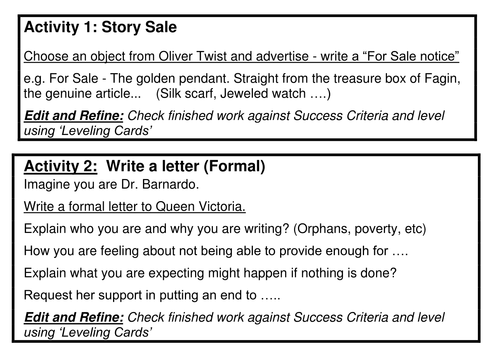
Oliver Twist: Writing Activities
Subject: Phonics and spelling
Age range: 7-11
Resource type: Worksheet/Activity
Last updated
22 February 2018
- Share through email
- Share through twitter
- Share through linkedin
- Share through facebook
- Share through pinterest

These printable English resource writing activities are brilliant as they provide cross curricular links with History (The Victorians), ICT, PSHCE, etc. They can also be used for SATs revision. I have used them in a number of ways - as a carousel (few activities at a time for the areas already covered in English), as one of activity at the end of a unit, as SATs revision. Search on TES for similar activities for Ancient Greek links - Hercules
Creative Commons "Sharealike"
Your rating is required to reflect your happiness.
It's good to leave some feedback.
Something went wrong, please try again later.
redtelephone
several spelling mistakes in this, but some helpful ideas.
Empty reply does not make any sense for the end user
lynnmarie96
Some excellent creative writing ideas!
karenlayermead
Iffatsardharwalla.
Surprised that you only gave 3 stars for such an amazing resource. Using this resource my class children achieved one of the highest SATS results in Essex. <br /> Thank you for using it through
Report this resource to let us know if it violates our terms and conditions. Our customer service team will review your report and will be in touch.
Not quite what you were looking for? Search by keyword to find the right resource:
- Starting a Business
- Growing a Business
- Small Business Guide
- Business News
- Science & Technology
- Money & Finance
- For Subscribers
- Write for Entrepreneur
- Entrepreneur Store
- United States
- Asia Pacific
- Middle East
- South Africa
Copyright © 2024 Entrepreneur Media, LLC All rights reserved. Entrepreneur® and its related marks are registered trademarks of Entrepreneur Media LLC
3 Types of Creative Blocks, and How to Overcome Them Science can help you understand the walls you're running into, when you struggle to start or finish a project.
By Amber Rae • Apr 24, 2024
Opinions expressed by Entrepreneur contributors are their own.
I had every intention of writing this article yesterday morning. And then again, last night. And then this morning. But my team needed me, I had a couple of fires to put out, and honestly, I just didn't really feel like doing it.
When I finally sat down to write, I realized what was going on: Procrastination was rearing its head. Or, as I like to call it, "Fear in overalls." Procrastination is a type of fear that has good intentions but lacks consistent follow-through, and it's easy to slip into. It's the part of us that says, "It's all good, I can do this later, I'm not really in the mood, I'm waiting for inspiration to strike."
As a bestselling author of three books, and a writing mentor who's supported thousands, I've learned a thing or two about why we don't start or finish projects — why ideas nudge us for years but rarely see the light of day.
Whether I'm supporting a founder with a track record of success, a New York Times bestselling author, or an aspiring writer who's just picking up the pen, creative blocks plague us all. Through my work, I've identified three types of creative blocks and how to overcome them.
Creative Block #1: Procrastination — "I'll do this later after I do that other thing."
Maybe you're reading this right now to avoid something else that you need or want to be doing. If so, you may be dealing with procrastination. But before you get down on yourself, let's look closer at the real cause. Unlike what many of us learned, procrastination is not a sign that we're lazy, weak, or lacking in motivation. Procrastination, from a psychological perspective, is also a survival function.
When we're stressed, overwhelmed, burnt out, or dealing with any perceived threat — which could be, "I really want this to go well but the outcome is uncertain," or "I want to put myself out there but I'm not sure how it'll be received," — our nervous system moves into a fight/flight/freeze response. In other words: we procrastinate.
Understanding the science of this can help us have compassion for ourselves—and others—and also decide what to do about it.
I learned about "micro-yeses" from my friend Britt Frank, a neuropsychotherapist and the author of The Science of Stuck . A micro-yes is the smallest next step you can take—a step so small, it seems almost ridiculous to call it "a step."
So, if you're wanting to write an article but you're stalling — like I was — the next micro-yes is not to schedule an hour to write. That might spook your nervous system and send you into further delays. In my case, my micro-yeses were:
- Get my tush in the chair.
- Write one bad sentence.
- Write another.
And voila, the brain stopped perceiving threats, my nervous system was more regulated, and I cranked out the article. I was on my way, and micro-yeses will help you get going, too.
Creative Block #2: Perfectionism — "This isn't good enough."
If procrastination is "fear is overalls," perfectionism is, as Elizabeth Gilbert put it, "fear in fancy clothes." Of all the blocks out there, perfectionism—and the pressure to be great right away—is one that will stop a project dead in its tracks before it ever has a chance to flourish.
When I landed my first book deal, my publisher asked me if I could write the book in three months. As crazy as that sounded, my book was titled Choose Wonder Over Worry , so instead of worrying about how unrealistic that deadline sounded, I asked myself: I wonder how I can get this done?
I cleared my calendar, flew across the world for a writing retreat, and then, as I sat down to write, I found myself paralyzed by a voice inside my head that chimed in every ten seconds to tell me, "That's a very bad sentence."
After consulting with a mentor (and nearly losing my mind), I was reminded that there is no such thing as a great first draft. In fact, my goal was to be a "bad writer" and write terrible first drafts, so that I'd get to the stage of having so-so second drafts and better third drafts.
That strategy helped me finish my book—and it's one that's helped many others in my signature writing workshop, On The Page . Revision is essential and will strengthen your work—but first you need to get those "pen miles" down.
Creative Block #3: Imposter Syndrome — " Who am I to call myself a writer? Am I going to get found out?"
If procrastination is "fear in overalls" and perfectionism is, "fear in fancy clothes," then imposter syndrome is "fear in hiding."
Whenever you're putting yourself out there, or trying something new, there will be people who will be more experienced, or knowledgable, or renowned than you. It's a simple fact of life. Whether you are just starting out in your career, or have decades' worth of accolades, there is always a fear that people who have achieved more will say: You don't know what you're talking about, or, who are you to think you can do this?
In fact, sometimes the more successful you are, and the more you've accomplished, the more likely you are to feel imposter syndrome. It's like the old saying attributed to Aristotle: "The more you know, the more you know you don't know." Case in point, I have a client who got a significant book deal on a topic that she's a world-renowned expert on. She's been featured in dozens of publications, she has a thriving business in her field, and her book is a vehicle to make her message more accessible to more people. And yet, on one of our calls, she shared with me: "I hope I can one day call myself a writer."
"What do you mean?" I asked.
"Well, I'm not a writer like those other writers," she said. "Maybe if the book's a huge success."
That right there is where imposter syndrome thrives: between internal doubt, and the belief that external accolades will prove we are worthy. And the most brutal part of imposter syndrome is that even if we reach our vision of "ultimate success," it's still not enough.
So what to do about it? The solution to imposter syndrome is two-fold:
- Notice the critical voice inside your head that says, I'm not enough, I'm going to be found out, I don't deserve this, I have to work harder to prove myself — and remember that voice is an old and damaging story that you don't need to buy into anymore. Notice it, remember it's not you, and as uncomfortable as it might feel, choose a more empowering narrative, such as: I'm already enough.
- Celebrate the progress you've already made—including the mistakes. Focus on what you're learning, how you're growing, what you value, and what is meaningful to you. Don't get caught up in what you'll need to "someday" achieve so that you'll finally arrive. You've already arrived.
I know encountering blocks can feel unsettling. But once we name what we're experiencing, we can recognize it more easily, and then respond to it differently. Creative blocks are challenges, yes, but they do have science-backed solutions. Sometimes it starts with lowering our really high personal expectations, rolling up our sleeves, and having a little faith in the process.
Author, speaker and writing mentor
Amber Rae is an international bestselling author, speaker, and writing mentor, best known for her acclaimed works Choose Wonder Over Worry, The Answers Are Within You , and The Feelings Journal . Through her work as a writing mentor, Amber guides creatives and entrepreneurs to turn their mission and message into stories worth sharing. Amber's writings and work have been featured in The New York Times, TODAY, Forbes, and New York Magazine , and she has collaborated with companies such as Kate Spade, Meta, Microsoft and TED. Her signature writing program On The Page with Amber Rae helps people break through creative blocks and get writing.
Want to be an Entrepreneur Leadership Network contributor? Apply now to join.
Editor's Pick Red Arrow
- James Clear Explains Why the 'Two Minute Rule' Is the Key to Long-Term Habit Building
- They Designed One Simple Product With a 'Focus on Human Health' — and Made $40 Million Last Year
- Lock Younger Americans Don't Necessarily Want to Retire in Florida — and the 2 Affordable States at the Top of Their List Might Surprise You
- I Tried Airchat , the Hottest New Social Media App in Silicon Valley — Here's How It Works
- Lock This Side Hustle Is Helping Farmers Earn Up to $60,000 a Year While Connecting Outdoor Lovers With Untouched Wilderness
- Are Franchises in the Clear After the Expanded Joint Employer Rule Was Struck Down? Industry Experts Answer 2 Critical Questions About What's Next.
Most Popular Red Arrow
Most people have no business starting a business. here's what to consider before you become an entrepreneur.
You need to find the right business opportunity at the right time and take the right steps to beat the odds.
AI vs. Humanity — Why Humans Will Always Win in Content Creation
With the proliferation and integration of AI across organizations and business units, PR and marketing professionals may be tempted to lean into this new technology more than recommended.
Who You Hire Matters — Here's How to Form a Team That's Built to Last
Among the many challenges related to managing a small business, hiring a quality team of employees is one of the most important. Check out this list of tips and best practices to find the best people for your business.
This Leadership Technique is the Secret to Optimal Team Performance
Through my experience in business, I've found one particular leadership technique that works better than others.
After Noticing That Dogs Had Better Fresh Food Options Than Babies, This Entrepreneurial Couple Started a Company. 50 Million Meals Later, They're Running the Fastest-Growing Kids Meal Delivery Company in America.
Ben Lewis and Angela Vranich, co-founders of Little Spoon, detail the launch and massive growth of their healthy baby and kids food brand.
7 Ways You Can Use AI to 10x Your Leadership Skills
While technology can boost individual efficiency and effectiveness, it's essential to balance their use with human intuition and creativity to avoid losing personal connection and to optimize workplace satisfaction.
Successfully copied link

IMAGES
VIDEO
COMMENTS
Write a story from the perspective of a Victorian domestic servant. What is life like for them and what challenges do they face in a life of service? Are there ways to advance their life and career, or will they dream of opportunities elsewhere? 4. Nom de Plume. A young woman living in a conservative Victorian household dreams of becoming a writer.
A boy fakes his own death, runs away from home, and teams up with another runaway for adventure. ( Huckleberry Finn, Mark Twain.) A mistreated animal comes into a better situation. ( Black Beauty, Anna Sewell.) On his deathbed, a father leaves his son a mysterious artifact with an equally mysterious message inside.
Victorian Story Ideas. In the bustling heart of London, a prominent inventor creates the first-ever automation that mimics human behavior to near perfection. As the elite clamor to own one, it's discovered that these automations are being used to replace real people in powerful positions.
In this post, we show you how to write a story set in the Victorian era through the following 10 top tips. Read on to find out more! 1. Understand Victorian sensibilities. One of the most important things to take into consideration when it comes to writing a story set in the Victorian era is to understand exactly what it means to be Victorian ...
25. Hotel of Haunts. Write a flash fiction story from the point of view of an owner of a hotel that is famous for being haunted by characters from the Roaring Twenties. 26. Let's Shake On It. Write a story about a man who purchases a 1920 Ford Model T and discovers that the car has a life of its own. 27.
by The History Quill. We're delighted to share this list of 60 historical fiction writing prompts to inspire your creative writing. We've put them on a historical timeline, starting in 399 BCE and ending in 1969. They cover a range of periods, places, and situations. Feel free to adapt them in any way you like.
Romantic Epochs. Cultural Revolution. Shadows of the Past. Turn of the Century. Conflict and Resolution. Artistic Endeavors. Explore the depths of the past with our list of 75 Historical Fiction Writing Prompts. Ignite your creativity and embark on a journey through time with compelling story ideas that bring history to life.
A Brief Overview of Writing Historical Fiction. Historical fiction writing prompts allow students to travel back in time and explore fascinating facts about the people before them. Plus…. The genre of writing helps writer's improve creative thinking and cognition and encourages them to think outside the box to write interesting fictional ...
Writing prompts and journaling prompts exploring Victorian era and related concepts - Explore over 50k writing prompts on DraftSparks.
Victorian Dining by Peter Breiner and Don Gillis. Victorian Edwardian by Alexander Faris. Victorian Love Songs by Craig Duncan. If you're writing historical fiction, I highly recommend listening to music from the era while you write. I find a lot of great songs on Amazon, and if you have Amazon Prime then you can listen to some of the music ...
Vibrant Victorians. A collection of creative writing tasks inspired by ten early silent films. This series of starter activities uses a range of silent films from the Victorian era as prompts for creative writing tasks. An illustrated presentation, featuring information about the films, discussion points and writing prompts, is provided for ...
These Victorian-era picture writing prompts are excellent for those reading stories like Pride and Prejudice, Emma, or Sense and Sensibility. The activity includes four pages with an image of a male or female character. Students can write a story about the character on one page or combine pages to create stories with two or more characters.
1. Choose two Victorian locations: The workhouse was a place where people too sick or poor to support themselves went to work (in return for food and a place to sleep). A 'baby farm' was a place where unmarried mothers send their babies - so they could go out and work. 4. Write the story from the most exciting part.
Victorian Literature and the Victorian State by Lauren M. E. Goodlad Studies of Victorian governance have been profoundly influenced by Discipline and Punish, Michel Foucault's groundbreaking genealogy of modern power. Yet, according to Lauren Goodlad, Foucault's analysis is better suited to the history of the Continent than to nineteenth-century Britain, with its decentralized, voluntarist ...
Victorian Tradition of Ghost Stories at Christmas Time. The tradition of gathering together to share ghost stories was popular in the late 1800s and into the early 1900s with British travel writer Jerome K. Jerome writing that "nothing satisfies us on Christmas Eve but to hear each other tell authentic anecdotes about spectres" in the ...
Welcome to our wonderful collection of Victorian themed resources for your English lessons. We have plenty of resources for fun and exciting Victorian themed writing ideas for your KS2 class, including newspaper writing, report writing and other creative writing activities. The Victorians were the people who lived during the Reign of the ...
It's time to write like a Victorian! Handwriting was very important in Victorian times. Ask children to step back in time and use this handwriting template to develop their style. Perhaps they could even hop in a time machine and write a diary entry as if they were a Victorian child. Welcome to Puffin Schools.
Year 5/6. Pupils should be taught to draft and write by, in narratives, describing settings, characters and atmosphere. This resource is part of the Effective Writing collection. Develop pupils descriptive writing by writing stories based in the Victorian era. Images and planning sheets are provided to support pupils to write engaging setting ...
The creative writing resources use images as a stimulus and are based on Victorian London, A Midsummer Night's Dream and developing tension in writing. There are also practice materials that prepare students for question 5 of the English Language papers 1 and 2 for GCSE. Suitable for higher ability year 7 or mixed ability year 8 groups. A ...
The module draws upon and enhances the core knowledge and research skills acquired in second year Victorian Literature focussed modules. As a hybrid creative writing and English literature module, it also makes up part of the creative writing pathway in the degree, connecting to creative writing modules in the 1st, 2nd and final years.
IKEA Tolsby/Fiestad Story Writing Prompt Frame 3 reviews. Finish the Adventure Story Writing Prompt 2 reviews. Creative Writing Prompts: Fantasy Story Dice 4 reviews. KS2 Tell Me a Newspaper Story: Writing Inspiration Activity Pack 4 reviews. Pencil-Themed Traditional Story Writing Prompt Fan.
Oliver Twist: Writing Activities. Subject: Phonics and spelling. Age range: 7-11. Resource type: Worksheet/Activity. File previews. doc, 113.5 KB. These printable English resource writing activities are brilliant as they provide cross curricular links with History (The Victorians), ICT, PSHCE, etc. They can also be used for SATs revision.
Writing is the final test out of the 5 selective entry tests. The writing piece can either be a creative or persuasive essay. Students will receive the topic on the day of the exam and have 30 minutes to write it, and planning time is inclusive. Planning is vital when writing an essay. With such a time limit, having a solid plan is vital to ...
Whether I'm supporting a founder with a track record of success, a New York Times bestselling author, or an aspiring writer who's just picking up the pen, creative blocks plague us all. Through my ...